November 19 - 25, 2017: Issue 338
World War I Historian Presents New Film on the Beersheba Charge at Avalon Beach Historical Society Meeting
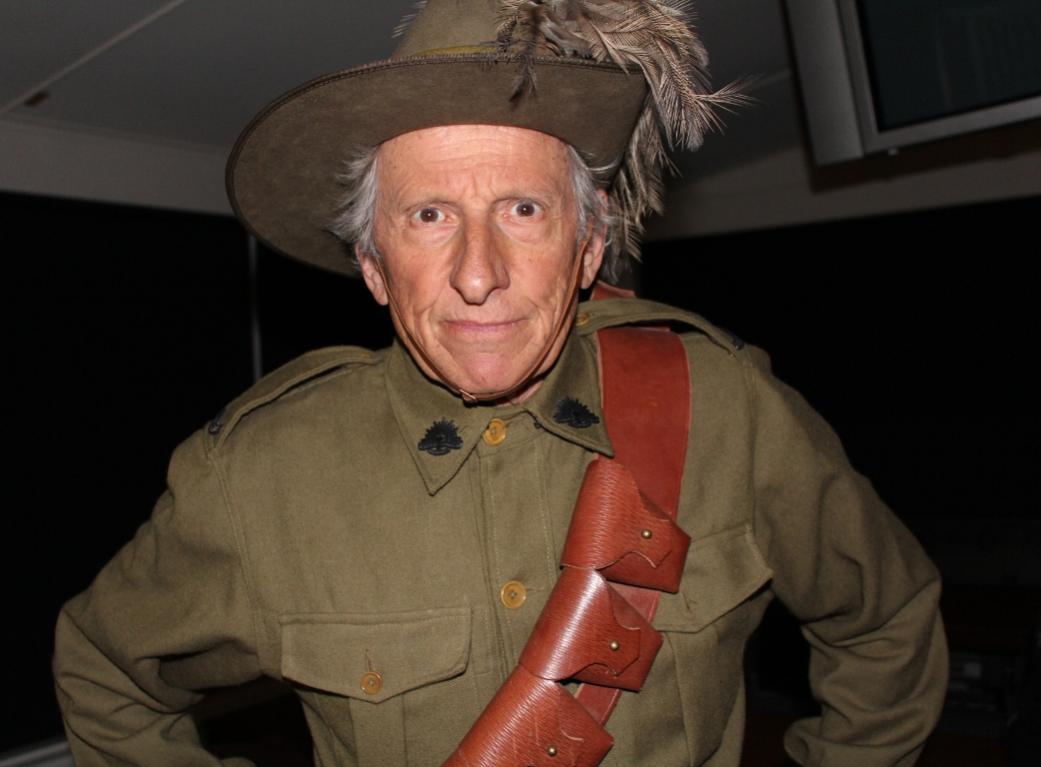
WWI Historian Dr. Jonathon King - A J Guesdon photo
ABHS Meeting: Tuesday November 14, 2017
On Tuesday members of the Avalon Beach Historical Society gathered for a special screening of Dr Jonathan King’s latest documentary, Palestine: Last Light Horsemen Tell All.
Dr. King, who was among those who recently took part in the re-enactment of the Battle of Beersheba and whose great-grandfather was among the soldiers in the original assault on the town, told the audience that it is very important to bring history to life through such re-enactments.
He should know; his award-winning live re-enactments of great historical events include the privately-funded 1988 Australian bicentennial re-enactment of the First Fleet when he sailed eleven square-rigged tall ships across the high seas from London into Sydney Harbour where three million spectators greeted his fleet on Australia Day 1988.
Dr. King stated the Battle of Beersheba, should become a cornerstone of Australia’s History as this was a Victory instead of a Defeat, which many see the slaughter that was Anzac Cove as.
It is also an event many Australians have some contact with. Among the audience on Tuesday night was John, whose Great Uncle enlisted in the Australian Light Horse in WWI or Beverly, another who had a relative in the 7th Regiment.
The documentary also brings into sharp focus the horses, which Dr. King explained in answer to one query, were ‘Walers’ named because they were the stock horses from New South Wales, a sturdy fit breed, and ‘Light’ because these were meant to transport men in battle; they weren’t carrying anything other than a trooper, as opposed to the work horses who were pulling heavy guns and doing ‘heavy’ work.
The mateship between man and horse is made palpable by the inclusion of such items as the poem ‘The Horses Stay Behind’ written by Oliver Hoe under the pen-name of ‘Trooper Bluegum’ and further on shows how Sir Harry Chauvel’s wish that these animals as well as their owners be honoured was met by his nephew Charles Chauvel in the film “Forty Thousand Horsemen”, which contains word for word the charge preface ('Do you intend to charge?' - 'I do sir'), and has as one of its stars Lovett Bay’s Chips Rafferty (John William Pilbean Goffage). His wish was continued by Chauvel’s daughter, Elyne Mitchell who wrote the Silver Brumby books and, along with Dr. King was among those who were part of the Tribute Ride for that famous bush poem, The Man From Snowy River, by Banjo Paterson, including a few references to the purported rider that most famous tale is about, Jack Riley.
Banjo threads are drawn in through the unfolding story as he was a war correspondent for some papers here and more importantly was the Veterinary officer for the horses in Palestine, had been met by some of the men who took place in that famous charge and whose interviews are also threaded through the way this film has been brought together.
One such interviewee, Len Hall, who rode ‘Q6’, a horse given to him by Sidney Kidman, states the credit for the charge on Beersheba should go to General Chauvel. His 1990’s talk with Jonathon King provides much food for thought, which we will not spoil by adding too many salient truths spoken here.
Dr. King was given a horse called ‘Queenie’ for his charge in taking part in this year’s centenary re-enactment, a ‘feisty’ beast apparently, and not the only testing note experienced by those who went to honour their ancestors and this almost forgotten piece of our legacy.
The victory also created the conditions for the foundation of the modern state of Israel - which the locals have not forgotten, King said this week. A protest formed part of the re-enactment, and not just in objecting to the flying of the Israeli flag as part of a historical re-enactment when that nation had not yet been formed, or returned to this ancient people. These young Australians helped demolish the centuries-old Ottoman Empire by driving the Turks from the strategic Suez Canal across the Sinai, and up through Palestine, Jordan, and Syria to be first into the enemy stronghold of Damascus — a victory that would change the course of the war.
The re-enactment will be part of the final version of this film, available in a few weeks.
Given so many original resources have been used to bring so many threads together, including the pamphlets for troops published then, Lawrence’s book “Revolt in the Desert” and even 1919 records and photos held by Avalon’s own John Stone, the unfolding of how these Australians led the charge and then led the retaking of these ancient Holy Lands, the first time they had been able to be entered by Christians since being taken over by the Ottoman Empire, makes this foremost among documentaries on this subject.
“It was history's last cavalry charge and it was the finest cavalry charge in history.” Dr King said.
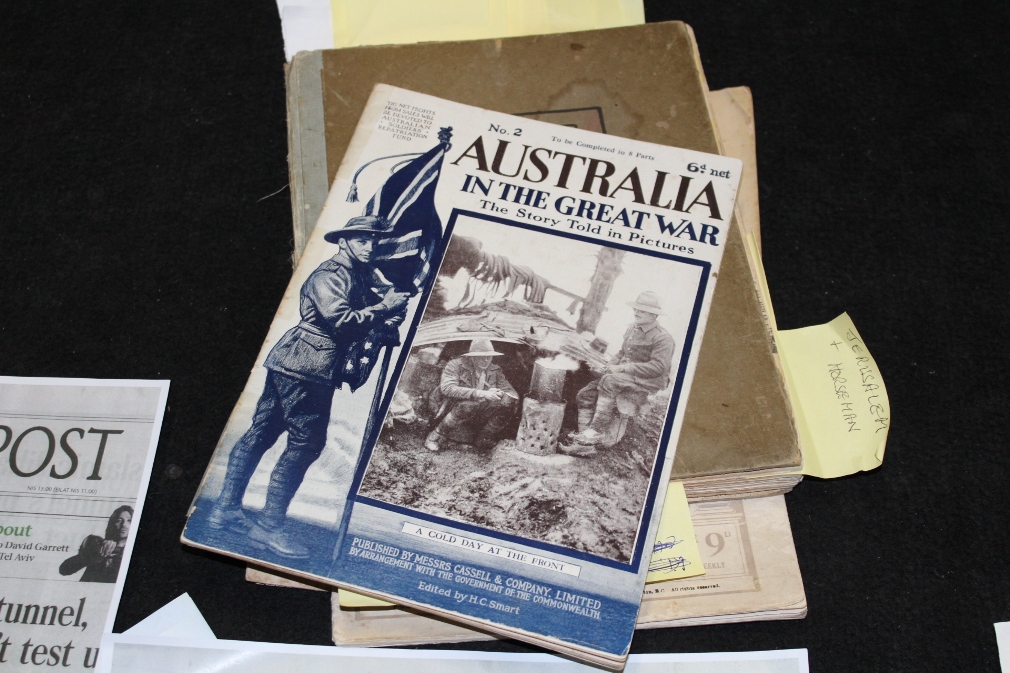
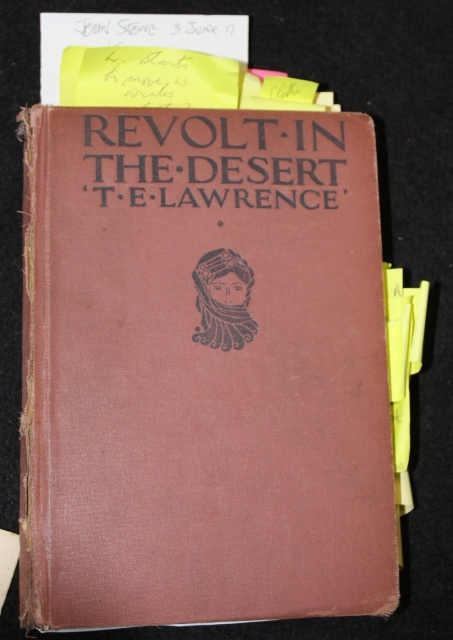 The men of the Light Horse Brigade were “ordinary stockmen, ringers, jackaroos, bushmen, they’d taken their own horses,” Dr King said. “They did so well because they were used to galloping across the plains in the Outback and shooting kangaroos or pigs from the back of their horses, so they were perfectly equipped.”
The men of the Light Horse Brigade were “ordinary stockmen, ringers, jackaroos, bushmen, they’d taken their own horses,” Dr King said. “They did so well because they were used to galloping across the plains in the Outback and shooting kangaroos or pigs from the back of their horses, so they were perfectly equipped.”About 100 of the light horsemen involved were Indigenous men, who were not even treated as Australian citizens at that stage. There were also Australian troopers of Chinese, Malaysian, Hong Kong and Singaporean descent, according to the Beersheba 100 years research project.
Narrated by Jack Thompson, who Dr. King met when both were much younger and working as a jackaroos, this work completes the trilogy of films the ABHS Member and respected Historian has worked on for years.
Dr. King’s film is dedicated to the 34 Light Horsemen from the 4th and 12th Regiment who died that day, the youngest being Colin Bull whose youthful face stares without mark or worry back at you in the closing frames of the documentary. Colin Bull was just 21 years old.
If you get a chance to see it when a Jonathon King Film and Talk pops up near you, as there are many small insights the gentleman provides as part of such presentations, go - or if you see the Notice we run when the final version is available to purchase as a DVD, grab one – there is so much content here, and so many threads skillfully woven to unfold this great true story, you will want to watch it again and again.
If reading is your preference, especially some great summer reading, get a copy of Dr. King’s Palestine Diaries The Light Horsemen’s Own Story, Battle by Battle.
Jonathan King’s Palestine Diaries: The Light Horsemen’s Own Story Battle by Battle was released by Scribe Publications in October. His documentary film, Palestine: Last Light Horsemen Tell All, screened on Foxtel’s History Channel on October 31.
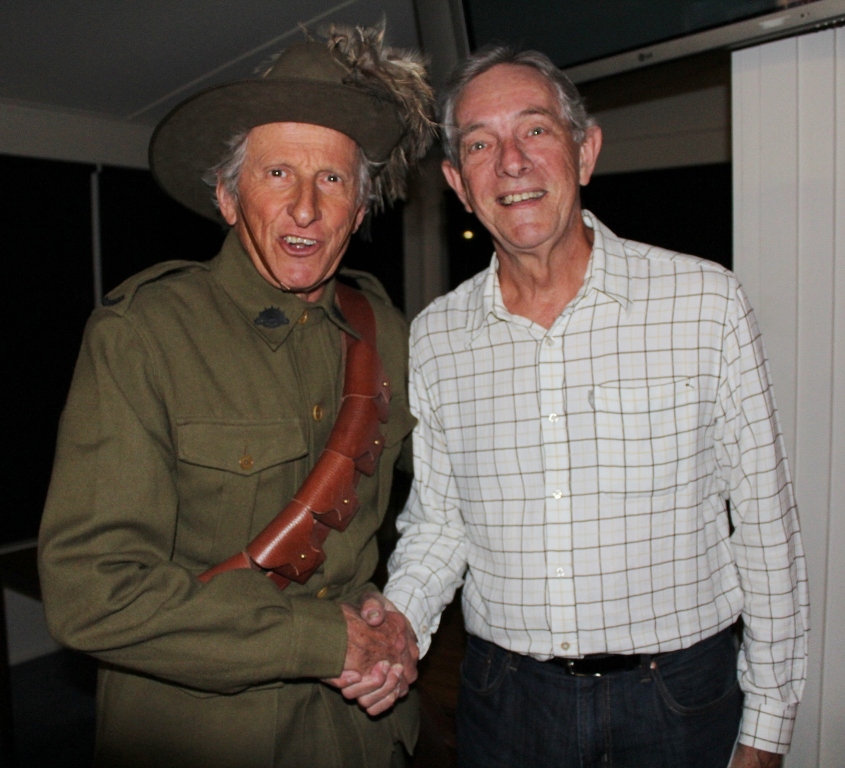
Dr. Jonathon King (also an ABHS Member) with President of the Avalon Beaxch Historical society, Geoff Searl.
About Dr. Jonathon King
(From the Jonathon King Website)
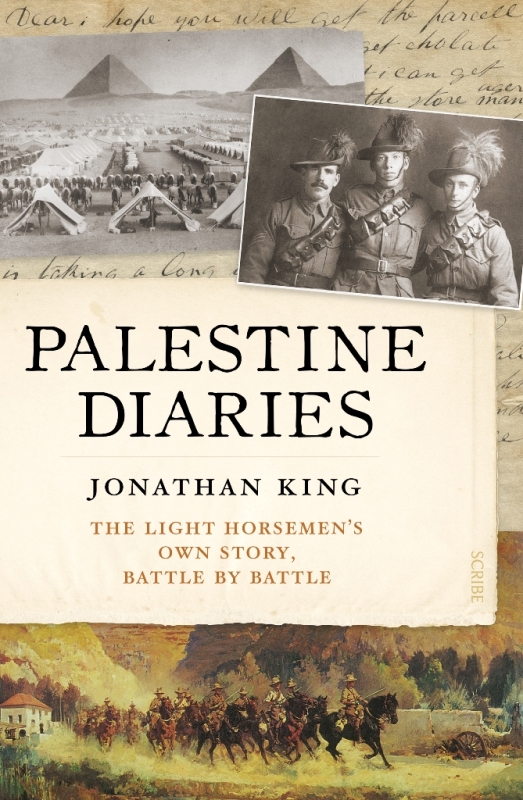 Dr. King is an extraordinary Australian who has led an extraordinary life - and one that his ancestor the 1788 First Fleet naval officer and New South Wales Governor, Philip Gidley King (who ruled 1800- 1806) would be proud of.
Dr. King is an extraordinary Australian who has led an extraordinary life - and one that his ancestor the 1788 First Fleet naval officer and New South Wales Governor, Philip Gidley King (who ruled 1800- 1806) would be proud of.Dr. Jonathan King has been described by The Australian as:
"A classic storyteller with a passion for history and the events that shaped the Australian nation - many of which he has brought to life through historical re-enactments".
Inspired by his passion for history Dr. King is an extraordinary Australian who has led an extraordinary life - and one that his ancestor the 1788 First Fleet naval officer and New South Wales Governor, Philip Gidley King (who ruled 1800- 1806) would be proud of.
Jonathan King's list of achievements have been many and varied, as he has used all types of mediums to tell his historical stories over the last thirty years and campaign to save the environment:
He is an award-winning author of 25 books on Australian History, he has written thousands of articles for newspaper and magazines, produced and presented more than 20 TV documentary films, appeared on hundreds of TV shows and acted as resident historian on many radio programs.
Fighting for the environment since 1988 he helped fund and organize the first national summit of the Australian Conservation Foundation, worked for the United Nations’ Environment Program and as director of Sting's Amazon Rainforest Foundation campaigning in both Australia and the Amazon with Chief Raoni of the Kayapo Tribe.
But Perhaps Dr. King's greatest achievements have been his award-winning live re-enactments of great historical events, including most famously, the privately-funded 1988 Australian bicentennial re-enactment of the First Fleet when he sailed eleven square-rigged tall ships across the high seas from London into Sydney Harbour where three million spectators greeted his fleet on Australia Day 1988 - Australia's largest live spectator event.
In 1988 he was presented with Australian of the Year Award (Victorian division) and in 1989 the Australian Achiever Award by the Prime Minister Bob Hawke for his fleet which was also voted best event of the Bicentennial Celebrations.
Dr Jonathan King says he has to walk, ride and sail in the wake of Australia's historical figures so he can bring history to life:
"I love telling my fellow Australians about their wonderful history and the best way to get the message across is to re-enact historical events." Jonathan King.
Some Background & A Few Pages from the Pages of then
Pittwater has further links with the training of Light Horsemen in that Mona Vale was utilised at the turn of the last century - visit Mona Vale Training Grounds - From Lancers On Horses To Lasses On Transport Courses.
The Battle of Beersheba was fought on 31 October 1917, when the Egyptian Expeditionary Force (EEF) attacked and captured the Yildirim Army Group garrison at Beersheba, beginning the Southern Palestine Offensive of the Sinai and Palestine campaign of World War I. Infantry from the 60th (London) and the 74th (Yeomanry) Divisions of the XX Corps from the southwest conducted limited attacks in the morning, then the Anzac Mounted Division (Desert Mounted Corps) launched a series of attacks against the strong defences which dominated the eastern side of Beersheba, resulting in their capture during the late afternoon.
Shortly afterwards, the Australian Mounted Division's 4th (Vic.) and12th Light Horse (N.S.W.) Regiments (4th Light Horse Brigade) conducted a mounted infantry charge with bayonets. Part of the two regiments dismounted to attack entrenchments on Tel es Saba defending Beersheba while the remainder of the light horsemen continued their charge into the town, capturing the place and part of the garrison as it was withdrawing.
General Sir Henry George Chauvel, GCMG, KCB (16 April 1865 – 4 March 1945), more usually known as Sir Harry Chauvel, was a senior officer of the Australian Imperial Force who fought at Gallipoli and during the Sinai and Palestine Campaign in the Middle Eastern theatre of the First World War. He was the first Australian to attain the rank of lieutenant general and later general, and the first to lead a corps. As commander of the Desert Mounted Corps, he was responsible for one of the most decisive victories and fastest pursuits in military history.
The son of a grazier, Chauvel was commissioned as a second lieutenant in the Upper Clarence Light Horse, a unit organised by his father, in 1886. After the family moved to Queensland he was commissioned as a second lieutenant in the Queensland Mounted Infantry in 1890, and saw service during the 1891 Australian shearers' strike. He became a regular officer in 1896, and went to the United Kingdom as part of the Queensland contingent for the 1897 Diamond Jubilee of Queen Victoria. In 1899 he commanded one of two companies of Queensland Mounted Infantry that were Queensland's initial contribution to the Boer War. After the war, he was closely involved with the training of the Australian Light Horse.
Promoted to colonel in 1913, Chauvel became the Australian representative on the Imperial General Staff but the First World War broke out while he was still en route to the United Kingdom. Chauvel arranged for the Australian Imperial Force to be diverted to Egypt, where he joined his new command, the 1st Light Horse Brigade, in December. In May 1915, it was sent dismounted to Gallipoli, where Chauvel assumed responsibility for some of the most dangerous parts of the line. He took charge of the 1st Division that November. In March 1916, Chauvel became commander of the Anzac Mounted Division, gaining victories in the Battle of Romani in August and the Battle of Magdhaba in December, and nearly winning the First Battle of Gaza in March 1917. The following month, he took over the Desert Column, later known as the Desert Mounted Corps, thereby becoming the first Australian to command a corps, and the first to reach the rank of lieutenant general. At Beersheba in October 1917, his light horse captured the town and its vital water supply in one of history's last great cavalry charges. By September 1918, Chauvel was able to effect a secret redeployment of three of his mounted divisions and launch a surprise attack on the enemy that won the Battle of Megiddo. He followed up this victory with one of the fastest pursuits in military history.
Major-General H. G. Chauvel, C.B., C.M.G.
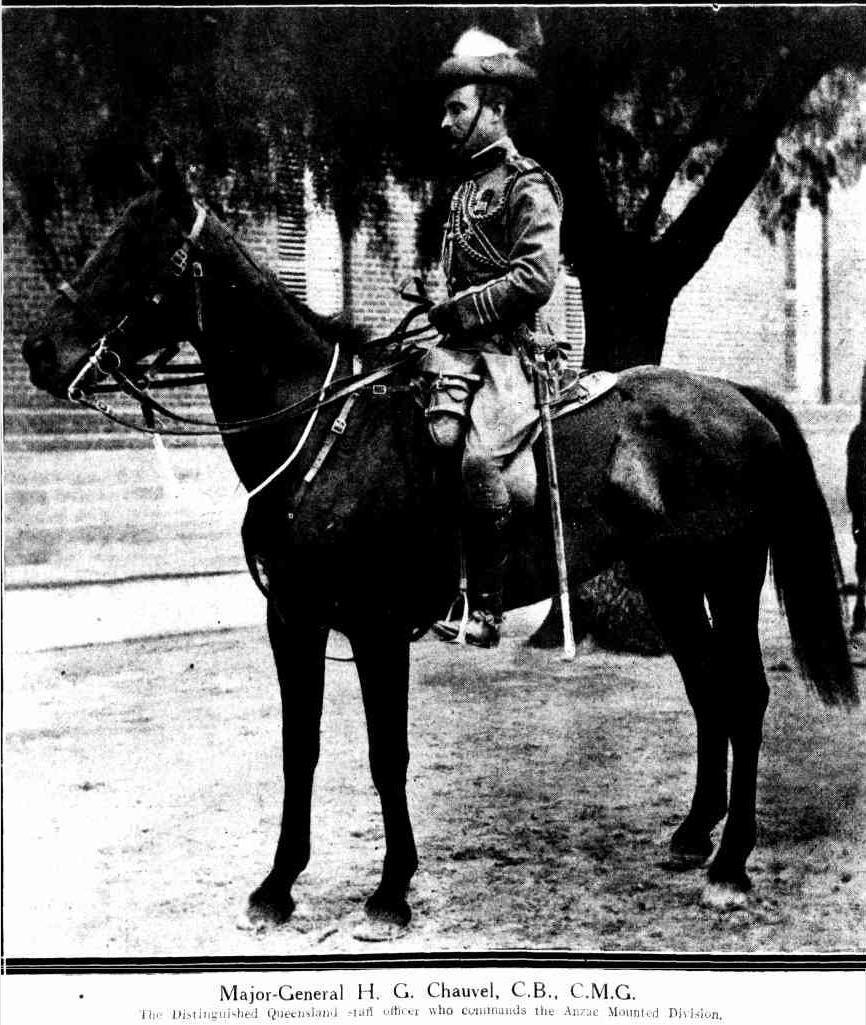
The Distinguished Queensland staff officer who commands the Anzac Mounted Division. GALLANT LEADER OF THE ANZACS AT ROMANI. (1916, September 6). Sydney Mail (NSW : 1912 - 1938), p. 18. Retrieved from http://nla.gov.au/nla.news-article160388113
GRAPHIC DETAILS OF THE ACTION'. Major-GENERAL CHAUVEL'S NARRATIVE.THE BATTLE OF RAFA. (1917, April 23).Townsville Daily Bulletin (Qld. : 1907 - 1954), p. 5. Retrieved from http://nla.gov.au/nla.news-article59290015
CHAUVEL'S MEN
FINE WORK IN PALESTINE. TURKISH RAILWAY DESTROYED
Dashing Raid by Anzacs.
LONDON, June 1
"Major-General Sir Harry Chauvel's engineering and mounted units of the Anzac forces in Palestine on May 23 dashingly destroyed 20 miles of the Turkish railway south-east of Beersheba, while Anzac and Imperial cavalry covering the raiding detachments reached to within five miles of Beersheba, and repulsed, an attack on two bridges by Turkish cavalry."
This is a passage from a despatch telegraphed from the neighbourhood of Gaza on May 21 by Mr. W. T. Massey, British press representative with the Egyptian army.
"The Turks," Mr.-Massey telegraphed, "have again felt the force of the British cavalry stroke. The British commander having decided to destroy the greater portion of the enemy railway south-east of Beersheba, mounted troops of the Desert Column, under General Sir Harry Chauvel, by another of those dashing raids which have characterised the columns since Christmas, simultaneously attacked 20 miles of the railway, and destroyed it beyond, repair. The operation was very important, because the Turks, owing to shortage of materials, have lately been obliged to take up old lines in order to lay down the new tracks.
"Two columns moved out on the night of May 22. The Camel' Corps "marched- 32 miles to El Anja, and destroyed bridges and culverts and the entire line to the eastward. Meanwhile the engineers and the Anzac and Imperial mounted men, after special training in destructive methods, attacked the railway between Asluj and Hadaj.
"These splendid forces marched 30 miles in an extremely dark night, throughout which a dust storm raged, obscuring the stars and obliterating all tracks, ever sharp, jagged stone ridges.
"One party reached Asluj at 6 o'clock in the morning, and the other reached Hadaj an hour later." They worked toward each other, and completer! the destruction of 10 miles of railway track and three long bridges substantially built of stone and concrete. …. CHAUVEL'S MEN (1917, June 2). The Argus (Melbourne, Vic. : 1848 - 1957), p. 19. Retrieved from http://nla.gov.au/nla.news-article1622625
In 1919, Chauvel was appointed Inspector General, the Army's most senior post. He was forced to maintain an increasingly hollow structure by politicians intent on cutting expenditure. He was concurrently Chief of the General Staff from 1923 until his retirement in 1930. In November 1929, he became the first Australian to be promoted to the rank of general. During the Second World War, he was recalled to duty as Inspector in Chief of the Volunteer Defence Corps.
Forty Thousand Horsemen (aka 40,000 Horsemen) is a 1940 Australian war film directed by Charles Chauvel. The film tells the story of the Australian Light Horse (mounted rifleman as distinct from cavalry) which operated in the desert at the Sinai and Palestine Campaign during World War I. It follows the adventures of three rowdy heroes in fighting and romance. The film culminates at the Battle of Beersheba which is reputedly "the last successful cavalry charge in history".
To raise funds for a movie, Chauvel shot a £5,000 "teaser" sequence, consisting of a cavalry charge based around the Battle of Beersheba. The cost for this was paid for by Herc McIntyre, managing director of Universal Pictures in Australia who was a long-time friend and associate of Chauvel's. Filming of this sequence took place on 1 February 1938 on the Cronulla sand dunes using a cavalry division of the Australian Light Horse, which had been performing in the New South Wales sesquicentenary celebrations.
The charge was filmed by a four-camera unit, composed of Frank Hurley, Tasman Higgins, Bert Nicholas and John Heyer.
Charles Chauvel also filmed some of his earlier works in Pittwater - Visit Filmed in Pittwater to read more.
BEERSHEBA VICTORY.
(Reuter's Message.) London, Thursday.- An official message states that 1800 prisoners and nine guns were taken at Beersheba. The British losses were slight compared with the results. London, Thursday.-The Sun's special representative wires:-The Gaza railway traverses the broad Valley of Hebron, and there is an excellent approach to Jerusalem, even if the railway is destroyed. Apparently the Turks were not in sufficient strength to hold both ends of the fortified line at Gaza and Beersheba. The recent constant raids by the Anzac Light Horse and the British cavalry kept the enemy guessing as to which end of the line would be General Allenby's objective. BEERSHEBA VICTORY. (1917, November 3). Goulburn Evening Penny Post (NSW : 1881 - 1940), p. 2 (EVENING). Retrieved from http://nla.gov.au/nla.news-article98877603
TAKING BEERSHEBA
ANZACS' FEAT.
London, Monday.—Mr Massey, official correspondent with the forces in Pales-tine, forwards a stirring despatch of the capture of Beersheba. He writes:—
"General Allenby's surprise blow, which smashed up the eastern end of the Turkish line, wrested Beersheba from the enemy. There was a stern fight throughout the day in which New Zealand and Australian mounted soldiers and British infantry displayed great endurance and courage, doing everything as planned. So the staff's scheme seemed to go like clockwork.
"The story of the day will add glory to the lads from the English cities, and shires, and the Australian and New Zealand men were splendid. The British infantry, after long night marches, attacked with such determination that they tore down wire entanglements with their hands. Then, as the moon rose over the hills of Judea, the Australian horse regiments dashed in on the strongly held trenches, and captured the town.
"At dawn, on October 31, the Australians and New Zealanders were south of Beersheba. The British infantry was facing the north-western and south-western defences, which were cut in a range of hills hiding Beersheba. In view of the fact that the Turkish entrenchments were elaborate, skilfully chosen, and heavily protected with wire, and as guns covered all the approaches, prisoners declared that they believed Beersheba impregnable. General Allenby's astonishing success in concealing the march across the sun-parched desert is the outstanding reason of the success. "The movement commenced with a cavalry scrap on October 27, when 3000 Turks, with 12 guns, attacked a British cavalry screen, occupying high ground near the Jerusalem-Beersheba railway.
"One British squadron held out throughout the day, though both flanks were enveloped. Another, surrounded on three sides, beat off two determined cavalry charges. When the infantry arrived the men were able to occupy the ground without fighting. "The British infantry marched in the night, hiding in the daytime in wadi beds.
"There was a beautiful moon on the night of October 30 and early morning of October 31. The Australians and New Zealanders made a wide, rapid sweep to the south-east in order to rush in at dawn and get astride Hebron Road, and thus prevent a Turkish retirement. The infantry attacked Hill 1070, and succeeded in an irresistible rush within half an hour, though a German machine gun section occupied the hill.
"The infantry then pressed on against the Wadi Saba trenches, making rushes across the open, and not heeding enfilading guns and spasmodic machine gun fire. Bombers dashed in wherever artillery broke down a wire.
"Elsewhere the Britishers tore down the wire from iron supports with their hands. It was grand work, the English countrymen showing inspiring courage and resource, though they had been fighting for 12 hours. They captured one defence after another until all Beersheba stronghold was captured at 9.30.
"Many Australians and New Zealanders rode 30 miles before getting into action. Their work was as meritorious as that of the Britishers. They first captured Sakaty, a high hill six miles north-east of Beersheba and dominating a wide district.
"With the usual elan these big Australians stopped at nothing. They had rounded up every Turk on Sakaty Hill by 1 o'clock in the afternoon. Then they captured Hebron Road. Even more difficult was the taking of Tel-el-Saba, a foothill three miles east of Beersheba, which was converted into a re-doubt of great strength, and made almost unapproachable by the steep banks of the Wadi, running alongside; but the New Zealanders and Australians carried it by 3.30. They then turned their attention to a group of houses between the hill and Hebron Road, held by German machine-gunners. This felt the full weight of the colonial arm. "It was getting dark, and there was anxiety about water for the horses.
"Other Australians settled matters. They formed up against the eastern trenches, fixed bayonets, and, charging line after line, went for the enemy. Before the last wave reached the trenches, the German machine-gunners were silent, telling a tale of enemy dead. Dismounting at the first line trenches, the Anzacs went on foot, overpowering all the Turks. Bringing forward their chargers, they galloped, cheering, into the town. They were the first to enter Beersheba.
"There was every evidence that the Turks had been completely surprised. A train was standing at the station; the warehouses were full of corn, and al-most intact. "The thirty-first was a great day for the army in Palestine. The staff work was admirable, and the morale of the troops never higher."
An official despatch from the British headquarters in Egypt reports:— "Our captures at the taking of Beersheba included 15 guns. The prisoners taken at Gaza totalled 444, including 26 officers.'' TAKING BEERSHEBA (1917, November 8).Singleton Argus (NSW : 1880 - 1954), p. 3. Retrieved from http://nla.gov.au/nla.news-article80707204
The Famous ' Waler' In War: Australian Light Horse On The March In Palestine.
See Article on Page 23' - 'THE HORSE IN WAR.'
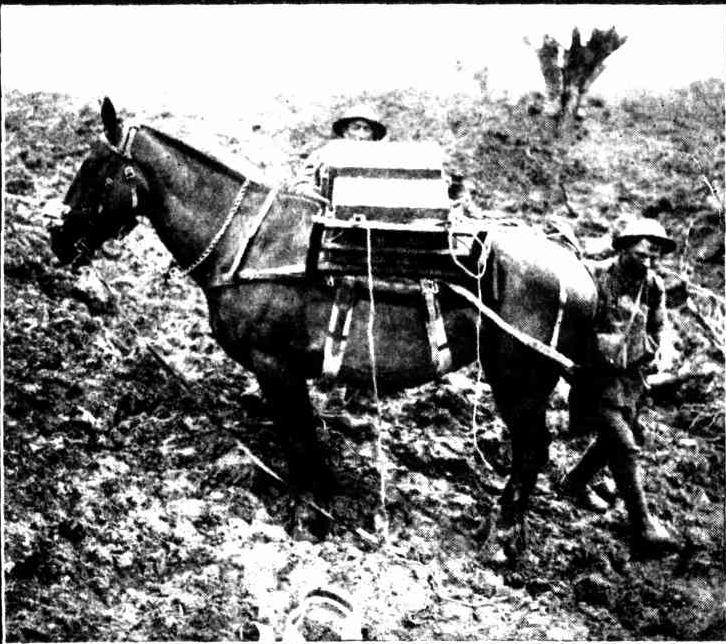
Loading a Pack-horse in a Shell Hole.
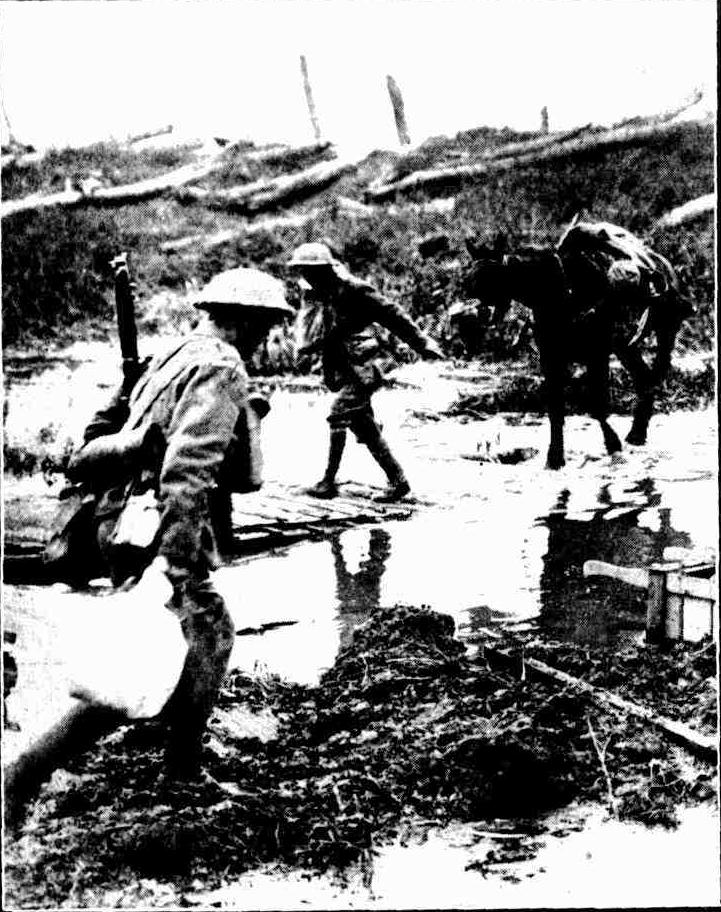
Crossing Flooded Country in Flanders.
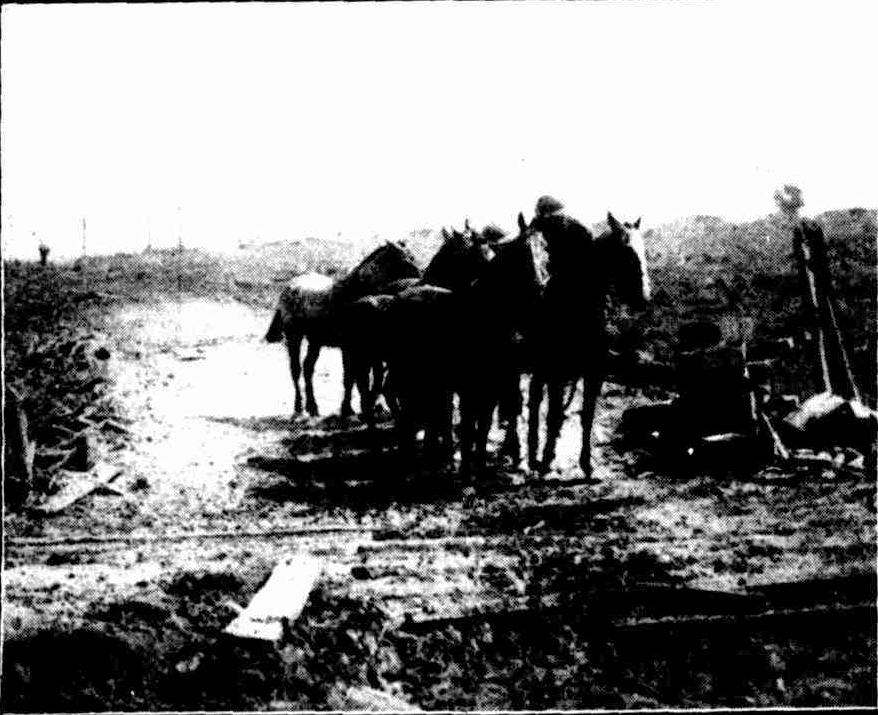
Bringing Up a Gun Team.
The three photographs reproduced above were taken on the Western front, where enormous numbers of horses are in constant use in connection with various war activities.
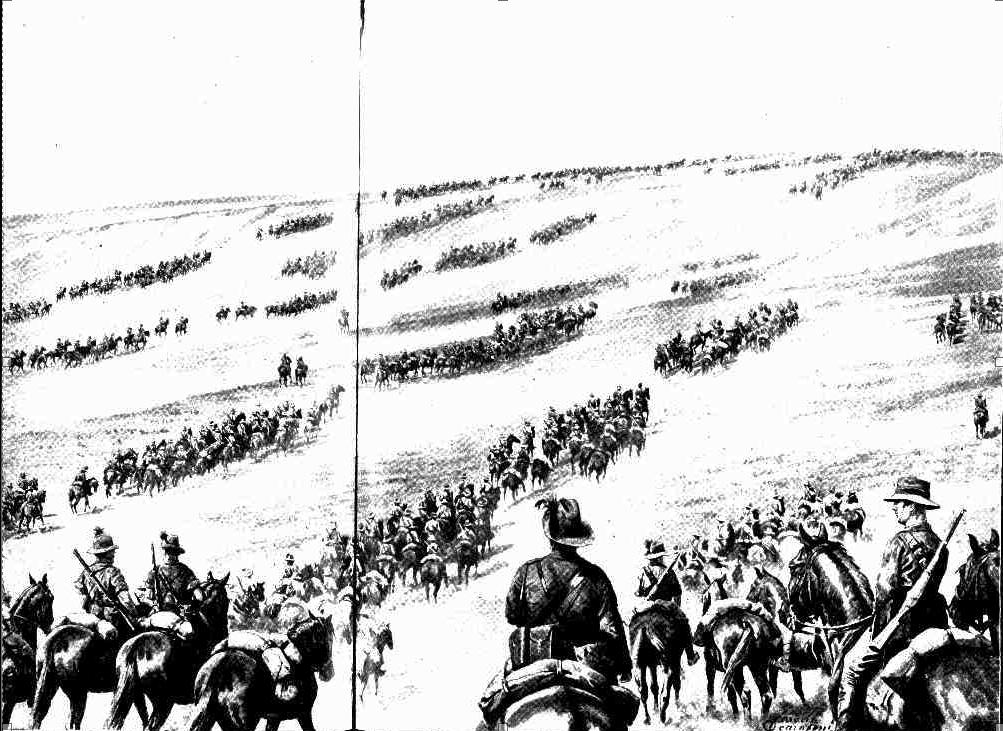
An exact enlargement in black-and-white, by Scaccia Searateni, from a photograph taken by an Australian trooper.
With the publication of this picture (which shows some of the Australian mounted men on the march in Palestine) comes appropriately news of an important British success, in which the Anzac Mounted Division, under General Chauvel, played a prominent part. General Allenby, Commander-in-Chief of the British forces, reports: — 'After a night march we attacked Beersheba Wednesday morning. While the infantry attacked the western and south-western defences the mounted troops made a wide turning move through the desert and approached the town from the east. We occupied Beersheba in the evening in spite of a determined resistance-' Operating with the Anzacs are several British mounted regiments, and an earlier report from General Allenby stated:— 'Three thousand Turks with 12 guns attacked our cavalry outposts on Saturday. Though outnumbered and enveloped, the London Yeomanry gallantly held their positions for six hours until reinforced. Their casualties were under 100, while the Turkish losses were heavy.' Beersheba is 40 miles south-south-west of Jerusalem, and about 27 miles south-east of Gaza, where the British and Turkish troops have been in contact for a considerable time. Apparently the British are now much stronger than the enemy
The Famous "Waler" In War: Australian Light Horse On The March In Palestine. (1917, November 7). Sydney Mail (NSW : 1912 - 1938), p. 18. Retrieved from http://nla.gov.au/nla.news-article160629777
The Horse in War: Value of the Thoroughbred.
By 'MILROY.'
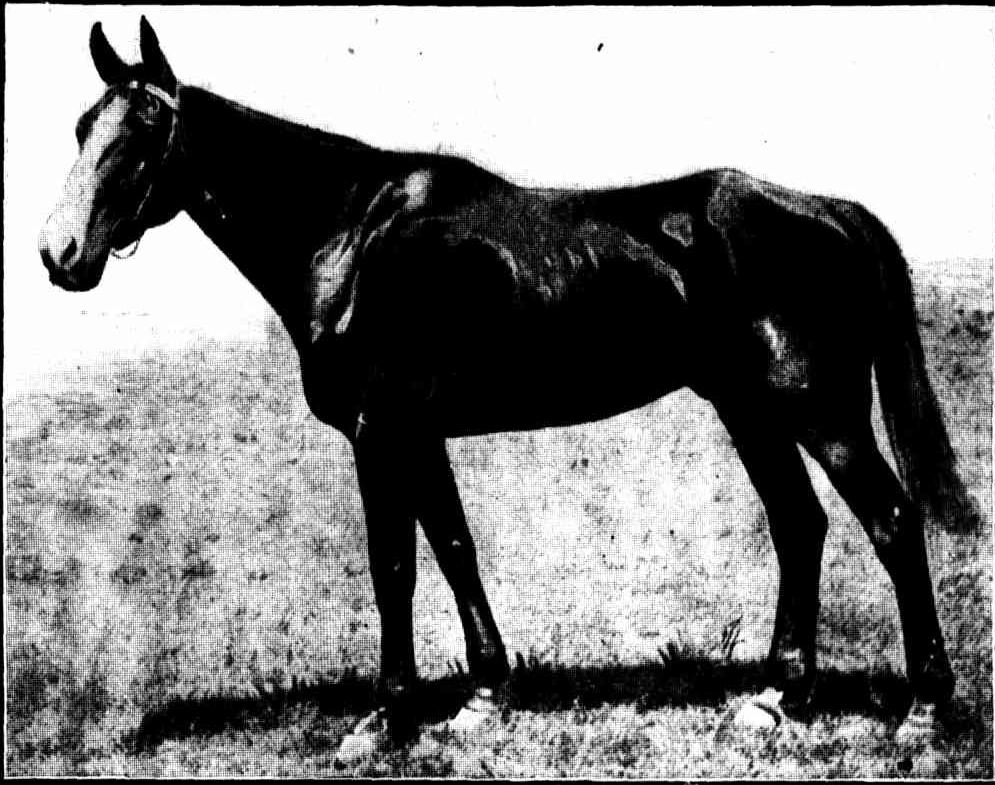
A Rightly Shaped Saddle Horse. This horse is by Faust (sor. of Kelpie) from a Roodee mare. His shoulders, depth of girth, bone, hind formation, and shape of loin are right, and he would have been backed to carry a lost mar. 100 miles from sun to sun off grass. When low in condition he was sent to Sydney as a right kind of charger to present to General Baden Powell, but the judges would not look at him. Subsequently he carried I4st Sib in a Hunt Steeplechase (4 miles), and won by nearly two furlongs.
THE public are not in the mood this year to take an ardent interest in the Melbourne Cup. They are under the influence of the world -shaking conflict to preserve our liberties. It is perhaps fitting to put forward certain views on horse-racing in relation to the breeding of horses for war purposes. So many objectionable associations have grown up about racing that one is apt to lose sight of the importance of the thoroughbred as a State and national asset. The time is not far distant when the public will no longer allow the subject to be trifled with. The war is bringing us down to essentials.
THE reform of racing is necessary, and it will ultimately be on the lines suggested here. There is a type of horse that is useful. There is a type that is useless. The breeder of the foal that will be a State asset should be encouraged. 'Milroy's' references to the Grafton family convey the lesson. The racecourse supplies the test, and if things were governed wisely no race would take place that did not accord with the true principles of breeding. From that point of view we look with .some pride upon the contestants for the two-miles event at Flemington.
THE AUSTRALIAN WAR HORSE.— Fifty years ago the premier English print relating to the sport of the 'gentlemen of England' was the 'Sporting Review,' which for many years took an interest in the breeding of hunters, and in order to improve them advocated the unstinted use of the thoroughbred stallion. The 'Review' is long since dead and forgotten, but many -if its unheeded advocacies have been proved correct by practical experience. This was particularly so during the Boer War, when English cavalry went out on beautifully-groomed,' high-stepping horses of particular type, to wage war with the wily Boer mounted on his veldt-fed and apparently half-starved pony.' The Boer could outstrip the English cavalry horse without turning a hair, while the Russian and Argentine horses were of little use to him. It is on record that the only horses capable of pursuing the Boer pony were the Australians, and a reason for that will follow later. The cleverly-turned English horses were not worth the water they drank, and they died by the thousand on the inhospitable plains of South Africa. After that experience Englishmen suddenly awoke to the fact that for the sake of show and vanity English cavalrymen had played unhappily with the good old three-parts-bred farmer mare who produced cavalry horses of note before the army man insisted upon the showy, but utterly worthless (for hard work), foals by hackney stallions, who are lovely park horses, but not the sort to clasp anything with a bit of thoroughbred in it.
CAPE ROARERS.— It was difficult for the English cavalry officers to understand how a mean, scraggy, lean, 15-hand horse could stream away from their beautiful cavalry horses — and beat them one mile in four. But the Indian' cavalrymen who were sealed up in Ladysmith knew. They -would have done something to the Boer in open spaces of the Cape Colony with their Australian 'walers' had opportunity offered. Why was the Boer pony superior to the £80 English hackney? Perhaps the following paragraph, copied from the 'Sporting Review' of March, 1856, will throw some light on the subject: — A great number of our blood horses go to the colonies, and about 100 stallions have landed at the Cape alone between 1840 and 1850, many of them with pedigrees a foot long, but sadly unsound and outclassed withal. Among the exportation were the symmetrical Battledore, Middleham, Fanny Boy, Evenus, Traverscr, Misdeal, Gam mon Box, Sylvan, Gorhambury, C'ockamonrh, and Mr. Martin. The Cape turf is said to have readied its zenith under Lord Charles Somerset; and the late Sir 'Walter Gilbert bore high testimony to the style in which the Dragoon Guards, weighing- on an average of 20st., were carried through the long marches by the sons of these English culls.
BEATING THE ZULU.— Lord Charles Somerset was 'dictator in South Africa for a lifetime, and was everlastingly fighting the Zulus. His soldiers were at first mounted on Basuto ponies, which the Zulus could outrun. Lord Charles recognised that it was useless fighting the black hordes without horses of a better class; so he journeyed to England, and held up Downing-street for a supply of thoroughbreds, with which to put some sparkle into the local pony. Downing-street couldn't and wouldn't understand. They had horses in Africa, and that was all that was wanted. It was a waste of time to tell them that the meanest thoroughbred would improve these horses 500 per cent.; so Lord Charles went out on his own, and at the expense of the Colony bought about 60 sf the cheapest and most defective thoroughbred stallions with a. number of indifferent mares, and shipped them to the Cape. They were mostly roarers or faulty in some other way — so bad, in fact, that a ' Review' poet flung the following at them: — ♦
Loud roared the dismal breakers,
Loud shrieked the wild sea gull
Hound barks with golden cargoes
Of thoroughbreds from Hull;
High blowers, cracks, and weedy ones,
As slow as any man,
From whose pyramids of forfeits
Their owners cut and ran.
Those were the forefathers of the Boer pony. Their foals badly beat the Zulu. The soldier could advance within range, fire at the oncoming foe, mount, and gallop away, dismount at leisure, load in the old ramrod style, mount, again fire, and off out of danger. But the time came when Lord Charles went the way of all flesh, and the breeding of Government cavalry horses got into bad hands, as all good things do. Sons of these originals were distributed among the Boer farmers, who kept odd horses as stallions, and bred from them from generation to generation without introducing fresh blood. The Boer pony, which was really more than half-bred, is the result. More care was taken in Australia by the various pioneer station-owners and their sons, to whom a saddle horse of class was a valuable asset. The result is 'the waler' of to-day, who is still accepted, even by the Germans, as the best cavalry horse in the world. The reason for this superiority, of course, is the fanatical adherence to the roughbred sires. In the early days of this country there was nothing small about importing a horse or a bull from England over a journey which occupied from eight to ten months in ships, that would hardly be fitted to-day for coal -hulks. When a pastoralist purchased a sire in England it was hardly worth his while to buy an inferior animal, that would cost as much to take over half the world fls would a good beast. Consequently, some of the founders of the Australian stud— therefore the Australian saddle-horse— were animals of good class.
History states that Rous' Emigrant was a horse of very fine class. He was brought here in 1828 from India in the warship Rainbow by the Hon. Captain Rous, who also fetched a very highly-bred horse named Theorem. They were presented to the Government. Captain Rous afterwards became an admiral and a turf dictator in England.
WALER HISTORY.— Sons of Rous' Emigrant were scat-tered far and wide, and our grandfathers told stories of their worth which the modern pony man could not be expected to believe. These pioneer stallions transformed the existing half-bred to an animal doubly superior to their mothers, and laid the foundation of the 'waler' breed, which is a household word in India, where the best Eng-lish cavalry horses failed more than 100 years ago, and Arabs were given a long trial, but proved worthless under weight. They gave way to the Cape horses that came into being at the beck of Lord Charles Somerset; but when the 'waler' was introduced the Cape horse went to the rightabout in less than five years. The first 'walers' sent to India came from the cattle stations on the North Coast of N. S. Wales and the central coast district of Queens-land. They used to send thousands of horses to India in little schooners, and only a very few men did the buying. The Upper Murray horses first brought the Victorians into the game. These all had a lot of breeding in them. The Bowlers, whose grant was where Warwick Farm Racecourse is now, trekked away south in the early days with Aether and Maeonides, two English stallions, and settled south of the Murray at Mitta Mitta. From their stud came sires of the great saddle horses of the Upper Murray. The Cressy Company, an English proprietary owning a lot of ground in Tasmania, did much to wards the improvement of the Tasmanian saddle horse, by introducing many stallions to the island State, among them such horses as Bolivar and Buffalo, but their efforts in this direction were no greater than those of Mr. Henty, whose work for Australia deserved a monument.
NOTABLE N.S.W. MEN.— In this State the Busbys of Cassillis, the Bettingtons of Brindley Park, the Scotts of Glendon, the Rouses of Guntawang and Biraganbil, Lieutenant Lawson of the Mudgee River, the Lees of Bathurst, Dr. Dobie and his successors, Bundock, Barnes, and Smith of Gordon Brook and Dyraaba, H. H. Kater, R. L. Dines, the Wyndhams of Bukulla, the Dights of Yetman, the Baldwins of Durham Court, Alexander Berry of Coolangatta, the HasseJls and Royds of Braidwood, and the Reynolds family of Tocal were the most prominent of the pioneers in the production of saddle-horses and sires of saddle-horses. In later days the Whites of Belltrees, the Coxes, and other prominent families did their share, and all stuck religiously to the thoroughbred sire. Such rich companies as the A.A. Co. and the Peel River Co.— who made immense money in Australia. — did comparatively little. In the long list of English tho roughbred importations New South Wales stands out supreme, and did so more particularly in the early days, when good horses were a necessity, and as the years advanced some of the studs have greatly improved their stock, while other families have paid more attention to sheep or cattle. Thanks to about six crosses of tho roughbred stallions on solid, substantial station mare foundation, the Whites of Martindale, Merton, Belltrees, and Havilah have produced a horse that Indian buyers gladly give high money for to sell as chargers in India. The same may be said of the Dangar horses bred at Neotsfield.
AUSTRALIANS IN EGYPT.— The value of a saddle horse is, of course, activity, vitality, and power to carry weight. It is always nice to have a good shape; but the roughbreds run into all shapes, and frequently the veriest' commoner to look at — who may be as plain as a pikestaff — is the best, through having inherited an extra share of that force that is found only in the thoroughbred. As a saddle-horse and a long-distance animal the thoroughbred is greatly superior to the Arab, who has been tried and found wanting, both in Australia and India, though many of the best saddle-horse studs were really founded on Arab blood imported in the very early days of colonisation from India; but the thoroughbred improved them, and in time wiped out all Arab characteristics, such as the square shoulders, outstanding hocks, and split-up quarters. Arabs do not breed their horses as we do. Our object is to breed the best with the best to get a foal superior to its parents, and while that continues we will always have a number of superior sires, whose second rate sons are invaluable for siring utility stock. The Arabs have no racing tests to guide them as to the presence of stamina in their stock. We have. The Arab's idea, of stamina is a long journey over desert sand. At the pace they go a three-quarter-thoroughbred would travel it for a month and hardly know he was working. That has been proved in the late war, when Australian soldiers, riding half-bred Australian horses, with 17 st up, outpaced the Turkish-ridden Arabs with very much lighter riders.
CLASSING BREEDERS.— Without a true test the thoroughbred horse would, in four or five generations, degenerate into ij the Boer . pony sort. The thoroughbred ; horse of 100 years ago was little more than a pony; but years of high feeding and training for heavy tests have developed the best, while the weak have gone to the wall. What is the test? The racecourse. There we can judge the value of a horse. The racehorse can be ; divided into about five kinds. I think about 5 ] per cent, are first-class, about 20 per cent, second-class, and 30 per cent, third-class. About 20 per cent, are fit for winning little odd 1 races where the company is poor, and the balance are worthless for racing purposes. 1 am j dealing only with males. Curiously, the best female racers are seldom good brood mares.
The very .greatest producers the world has known were mostly non-performers. The worthless division of males should not be bred from. They should be gelded and used for saddle and harness work, and no pony should be used as a stallion, for the tendency with the roughbreds is to run small; therefore it is absurd to allow people the opportunity of raising a race of ponies The pony is very good for a girl or a. boy to ride; bur no matter how high its vitality, a big weight will crush it at heavy work. It is possible to so organise our horse breeding forces as to make it compulsory to use- the first division of males for the production of racing stock of the best class, the second division for racing and utility stock, and the third for utility work only.
UTILITY SIRES.— Of course, that would be objected to,', and with some reason, because several high-class stallions were utter failures as racehorses or did not race at all. Such instances are Grafton, Simmer, aud the noblest Roman of them all, Australian Sir Hercules. But if a top-notcher happens to be banished to an outside station, as were Neckersgat and Ay,- Laddie, the vitality of their stock would tell the ordinary horsemaster they were too good for utility work, and they would come back into their proper sphere. Ayr Laddie was sent to t Thompson River station, but came back later to Oakleigh, where he became a leading stallion, and left many sons who should be invaluable in the siring of saddle horses. Where would one find bettor stamps for station work than Ayr Laddie's sons Hartfell, Jolly Beggar, Lucky Beggar, Cider, Cagou, Dear Laddie, Faithful Laddie, Canargu.?, Silver Lad, and not a few others equally as shapely? Ayr Laddie was a beautifully-shaped horse, but his stu-l mate Grafton was of tremendous size and not --o well turned. However, bis sons are the very thing Austra lians want. Frank O'Donnell and his brother, who s.re big horse buyers in Australia, once asserted that Indian soldiers should raise a monument to Mr. Agar Wynne, the importer of Grafton, for no finer horses for cavalry work than those by Graf ton's second-rate sons have ever been.
GRAFTON'S SONS.— The Graftons are good-looking, have size, are brave, and generous, and can jump anything. Grafton's value as a sire of racehorses is well known; but his value as a sire of utility stallions is incalculable. The same may be said of Lochiel; while sons of Simmer are doing wonderfully well, though, when Simmer left Eng land, an English writer was good enough to say lie could neither gallop, trot, nor walk; but the Australian climate brought to the surface the latent qualities of the tho roughbred that were dormant in him. As before remarked, without the racecourse we would have nothing to guide us concerning the quality of a horse — one cannot depend upon looks. But there are racecourses and racecourses. It is from Randwick, Flemington, Eagle Farm, Perth, and such tracks we gather the knowledge we require. The Sydney pony tracks are absolutely worthless for that pur pose, and are of no value to the State or anybody at all. except the proprietors, who make from 100 to 500 per cent, on their investments. Real ponies are of little value in a stud of thoroughbreds. Steeplechasing is also a fallacy.
IMPROVING BREEDS AND PRICES.— We seldom see a stallion running over fences, and very few full-blooded horses. A journey of three miles over fences is nothing much for a horse able to jump; and jumping is mostly n. matter of practice. In hurdle racing they go at a faster pace, and it is a truer test of stamina. Though our saddle horses rank high wherever they have been, it is easily possible to improve them by wiping out these wretched proprietary pony tracks — which in time may wipe out horse-racing altogether — and by working on a co-opera-^ tive principle in the sale of cavalry horses for export. If the breeder sells direct to army men of India or Eng land, instead of ?allowing; the middlemen to ^rab 60 per -_-. cent, of the horses' real price, theiv would be, more inducement to breed remounts. If a breeder could sell hi* cavalry remounts at, say. £35 a head, delivered on the boat, there would be better proPt in the business. As things are, he has to take from £12 to £15. . All breeders know the dealer gets £45 a head in India, which mean* £3t in Australia. In every farming restrict we find a few mongrels without breeding or good looks travelling ; ' ; at the usual 30s rate. Unless a horse can show at least six strains of the thoroughbred he should be gelded That would be a better cure for many evils than would .;' be a stallion tax, which, if it comes, will only be regarded as a revenue measure — not a means of improving the horse.
The Horse in War: Value of the Thoroughbred. (1917, November 7).Sydney Mail (NSW : 1912 - 1938), p. 22. Retrieved from http://nla.gov.au/nla.news-article160629818
AUSTRALIAN GENERAL IN PALESTINE
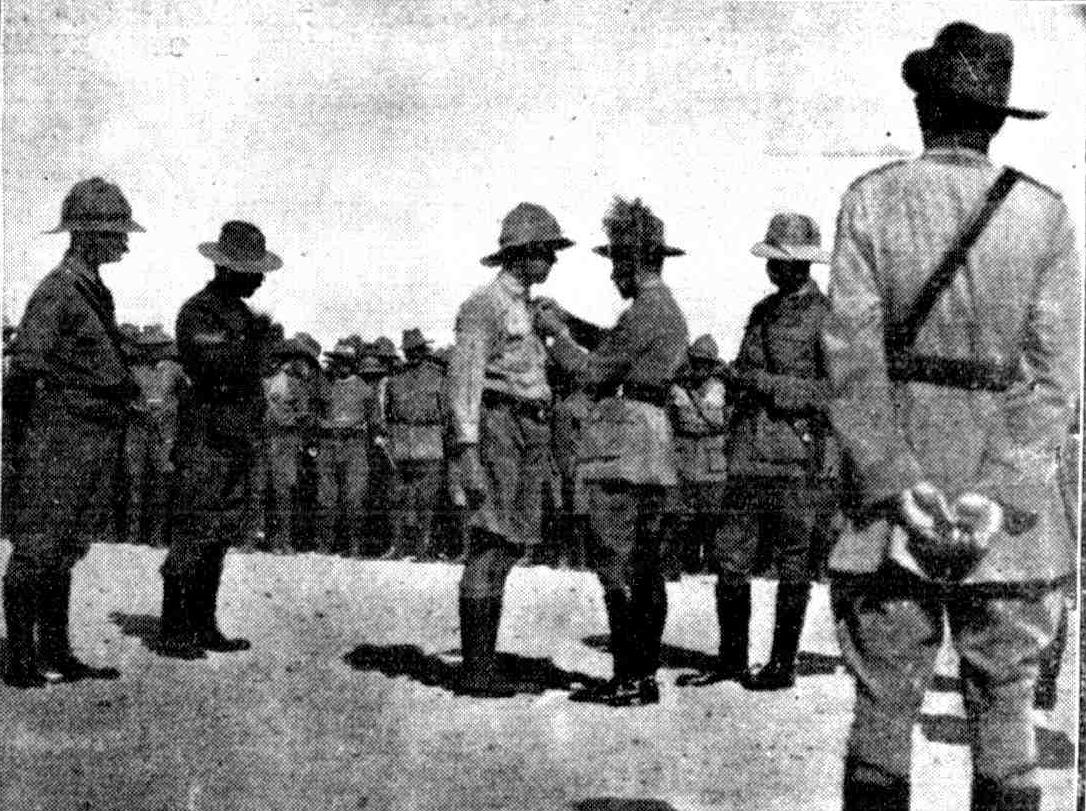
LIEUT.-GENERAL CHAUVEL DECORATING AUSTRALIAN SOLDIERS IN PALESTINE.
AUSTRALIAN GENERAL IN PALESTINE (1917, November 3). The Mirror (Sydney, NSW : 1917 - 1919), p. 15. Retrieved from http://nla.gov.au/nla.news-article116969174
SYDNEY HEROES. (1917, October 3). The Sydney Morning Herald (NSW : 1842 - 1954), p. 12. Retrieved from http://nla.gov.au/nla.news-article28100891
WITH THE ANZACS IN SOUTHERN PALESTINE.
THE BATTLE -AREA IN PALESTINE.
BY C. J. B. MARSHAM.
A stirring story of how the Anzac Mounted Division helped to capture Beersheba appears on Page 27. In the operations at Beersheba and Gaza nearly 3000 Turks {including over 200 officers) have been captured.
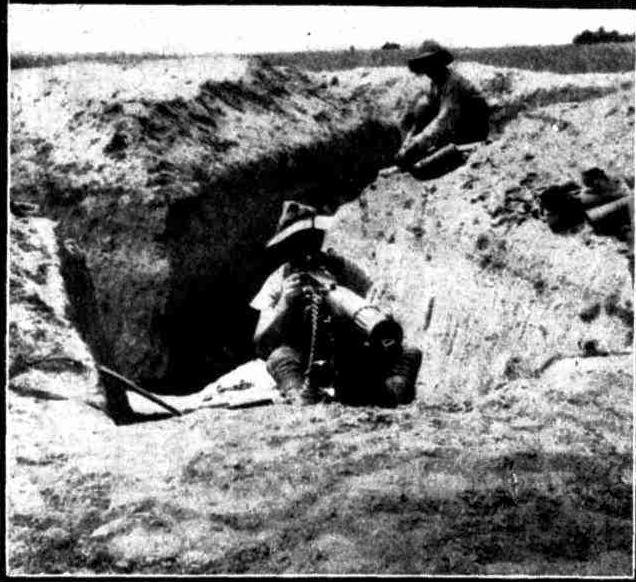
In an Abandoned Turkish Trench. The Turks are great trench diggers, doing' their work very thoroughly.
THE country in which we are now operating is on the fringe of the desert which divides Egypt from Palestine. It does not, as far as our observation goes, flow with either milk or honey; if it would only flow with water we would ask no more of it. It has been a battlefield from time immemorial, a Flanders of the East. The first conflict between Egypt and Assyria took place here, when
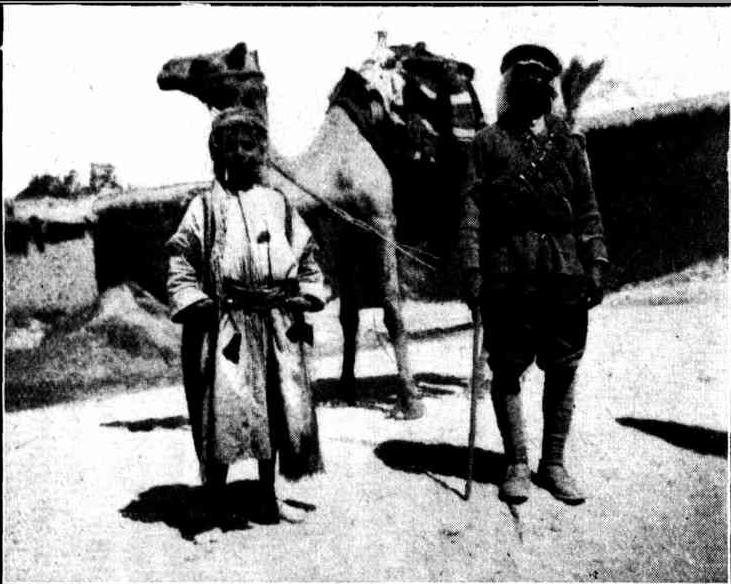
A Soudanese Member oi the Egyptian Intelligence Corps (in Uniform).
Bocehoris, King of Egypt, sent an army to help Hanun, King of Gaza, against Sargou. And, later, the Pharaoh Hophra, coming to the assistance of Zodekiah, against the Babylonians, captured Gaza and enjoyed a short-lived success. Other battles have been fought here both before and since. Modern Gaza is said not to be on the same site as the ancient city, with whose gates Samson made so free. It looks a pleasant enough town; but I doubt if it is a very healthy spot in which to live at the present time.
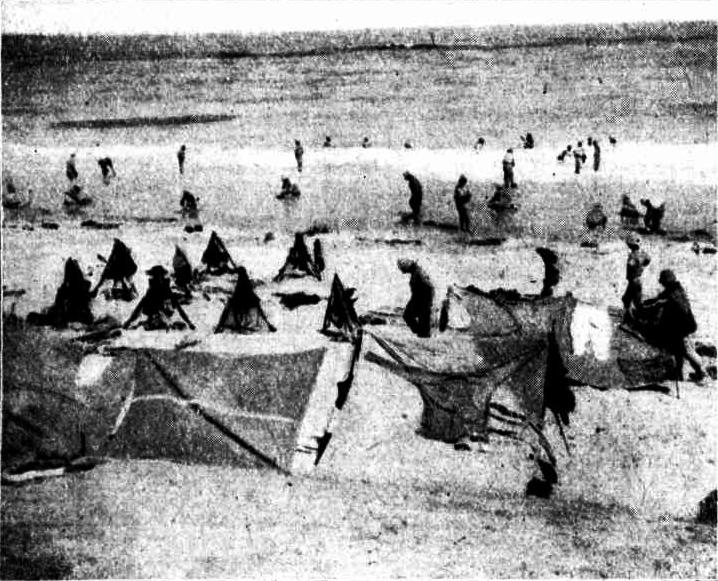
French Troops Bathing on the Beach near Gaza.
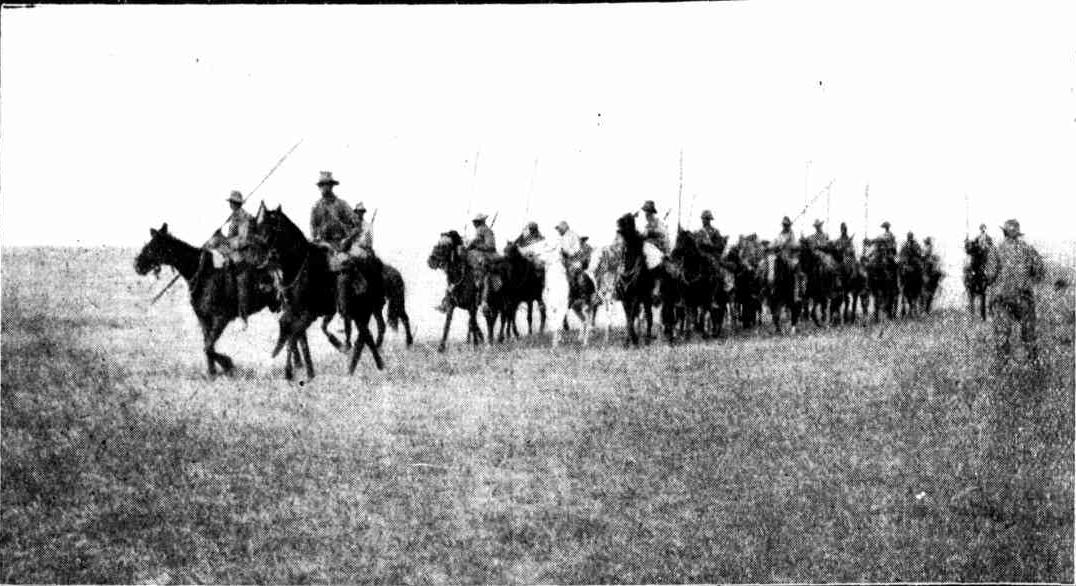
Escorting Turkish Cavalry into the Australian Camp. The Turks' lances are being' carried by their captors. They are made of hollow steel 9ft long'. The Turks wave also armed with sword and rifle, and carried bombs in their saddle wallets.
THE country around our present railhead is a country of rolling downs, not unlike some parts of England. Much barley is grown here, barley with little straw, but with the suns-nine in it, such as the brewer likes for his bitter beer. Some day a golf course may be made here, and it will be a good one, and the Championship of the Near East may be fought for on it. Inland the country is flatter, and beyond the Turkish lines is a range c,f hills stretching away to Beersheba in the east. The wadis (or dry watercourses) are the most distinctive feature — a great sight they must be after a heavy storm. The soil, being a sandy loam, with the sand in most places predominating, affords little resistance to the torrent, which cuts its way through to a great depth, leaving a river bed with steep banks — a serious obstacle to men or horses, but excellent cover fro in shell and shrapnel. The most important of them is the Wadi Ghuzze, which varies in width from about 30 yards to fully half a mile. In the wider parts it is broken up by grass-covered hillocks, and its bed consists mostly of deep sand.
NEARLY every face of the British Empire is represented on the beach at bathing time — men from almost every county in England, Scotsmen, Irishmen, Welshmen, Australians, New Zealanders, Indians, and Egyptians of all types. The scene is an unforgettable one, and it is a great pity that there is no artist to paint it. The Australians and New Zealanders are thoroughly at home hi this kind of life. Their uniform consists of a slouch hat, a quarter of a shirt, and some sort of boots and breeches*. They are great fighters, with a high sense of personal honour and the most cheerfully helpful fellows to meet in any sort of difficulty. There are two curious isolated plateaus which at once arrest attention. They are something more than hillocks. They can hardly be dignified by the name of hills. Their names are Tel el Jemmie and Tel el Fara, and they are invaluable landmarks in a country in which it is wonderfully easy to lose one's way. They have been used at various times as places of burial, and bones and coins have been found in them. Wherever there is water — as there is near the sea — fig trees and olives appear to flourish. In some places, as at Khan Yunus, the gardens are divided by enormous caclus hedges, forming an obstacle which looks strong enough to keep out an elephant. In the main, however, it is a dry and treeless land, and only in the evening hour could it be described as beautiful, the light of the setting . sun lending a softness and variety to its colouring which at other times it lacks.
ALTHOUOH so close to Egypt, and enjoying a climate so similar, Palestine appears to differ widely from it in many respects. The flowers, for instance, are quite distinct, and I do not recollect seeing one, except it be the scarlet poppy, which is common w both countries. I expect early spring is the best timefor them, and that we arrived there rather late. Besides the scarlet poppy there is a red and yellow one with a long seed-pod like that of our English yellow sea-poppy. There are also two kinds of convolvulus, a small white one and a larger one with pink flowers. All these plants grow in the cultivated land.
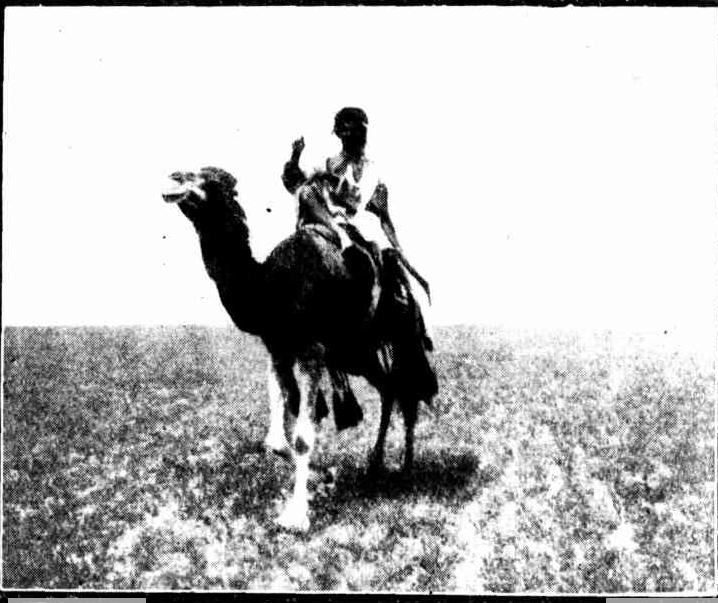
A Hostile Bedouin in Palestine
In the uncultivated down land there is a beautiful dianthus with a pink flower and a long stalk, and a low-growing mauve plant which looks like a heath, but isn't. It has a very strong scent — a quality which it shares with the dead camels, which are also not uncommon. There is also a pretty plant with clusters (racemes, I think the botanists call them) of a small white flowers. Several kinds of thistle with peculiarly sharp spikes grow here; one with a yellow flower and one with a mauve I remember especially.
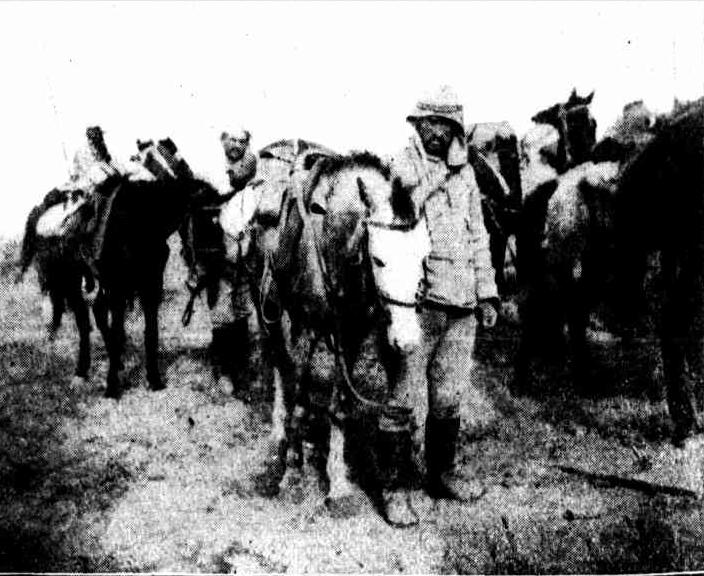
Turkish Cavalrymen Captured by the Anzacs.
I have sat on them all, and there is not much to choose between them. Of birds I saw a considerable number. Vultures frequent the wadis and I have seen five together wheeling round each other, and systematically searching the ground. Crested larks are as common here as in Egypt, but I saw no water wagtails. the other common Egyptian bird. There were a great number of quail in the cornfields in early April, but they soon left. Swallows were fairly plentiful, as also were bee-eaters. I once saw five sandgrouse together; they let me get within about 50 yards, and then flew away a short distance and settled again. A pair of fly catchers had built their nest close to our brigade headquarters, and brought up their young ones regardless of shells and shrapnel. The cock is a dapper little bird dressed in black and white, and looks as if he were wearing the curious garments, which we used to call evening clothes.' The hen is soberly clad in brown. If fly-catching was their profession, I fear they had not been a complete success, for flies were our great est infliction. Drastic sanitary measures have now done a great deal to diminish the evil. Nothing, however,'' could save us from the other discomfort—the sand, which blew continually in eyes, nose, mouth, and food. The climate on the whole is de lightful—at least, in the spring and summer, the heat being tempered by a sea breeze which springs up punctually at 9. SO every morning; so that the early hours are usually the hottest. When the wind blows from the desert, as it does occasionally during the Khamseen, or fifty days of spring, life is a burden to man and beast. The wind is high, intensely hot, and absolutely dry, and brings with it quantities of sand.
THERE are large numbers of sea shells in the soil, nearly all of them of one type, a bivalve of about lj.in in diameter. They must be, of course, of great antiquity; yet the same shell is to be seen on the beach to-day. There are snakes in this part of the country also; but I have not heard of any case of snakebite. On the other hand, a good many men have been bitten by scorpions, which, though not so serious, is no joke, especially if the assailant is one of the large black variety. Tarantulas, also, are fairly common, but they run away when-ever possible, and only bite if driven into a corner. There are also ants in great variety and abundance. Lizards, too, are very numerous; and I noticed four or five different species. They are, of course, perfectly harmless, though the Arabs say there is one sort which has a poisonous bite. Take it altogether, it is by no means a bad country for campaigning. One need never be cold, and can never be wet, and the nights are so warm that if you do lose your way it is no hardship to lie down and sleep where you are. The nights, indeed, are wonderful, especially when there is no moon to dim the stars, which shine with a living brilliance not seen in our homes of cloud and mist. WITH THE ANZACS IN SOUTHERN PALESTINE. (1917, November 14). Sydney Mail (NSW : 1912 - 1938), p. 26. Retrieved from http://nla.gov.au/nla.news-article160628984
BEERSHEBA.
(By. LIEUT. H. BOWDEN FLETCHER. D.F.C.)
November 1, 1917.— What a day it was! For General Allenby ended the stalemate before Gaza and showed that with good generalship the Egyptian Expeditionary Force was one of the finest fighting machines in existence. The failure of the second battle of Gaza led to the removal of Sir Archibald Murray from the command and the appointment of Sir Edward Allenby. Immediately upon Allenby's arrival things began to hum. Firstly, the general staff, who were living in snug quarters in Cairo, 150 miles from the front line, were bundled out and quartered in huts erected on the outskirts of Belah, where the commander-in-chief could be in touch with the moving events and be among the troops themselves. It was almost immediately noticed that organisation was being speeded up, fresh guns and other implements of war, including aeroplanes, began to arrive in ever-increasing numbers; and the troops themselves soon showed the change in their more confident bearing.
Preparations soon began to indicate the nearness of a big stunt, and with bitter memories of the two previous attacks on Gaza we awaited developments with considerable interest. The push was timed to commence at dawn on November 1, and for three days and nights previously the guns of the force and the navy, assisted by aerial bombs, concentrated a tornado of fire on the historic city, transforming it into a veritable shambles. Under cover of this bombardment the whole of the mounted troops, under Sir Harry Chauvel, were moved to our right flank fronting Beersheba. They were hidden in the many hills in that vicinity. The terrific shell fire at Gaza impressed on the Turkish mind the idea that a frontal attack was to take place there, and the Commander-in-Chief of the enemy depleted Beersheba of its reserves to assist in defending Gaza, thus weakening his left flank, which was actually Allenby's point of attack.
Under cover of darkness, the mounted troops made a long, forced march over a waterless, stoney desert. They succeeded in getting behind Beersheba on the night of October 31, and at dawn on November 1 commenced the attack. By 4 o'clock in the afternoon the capture had been effected with a spectacular mounted charge by the 4th Light Horse Brigade, under General Grant, for which he was awarded a bar to the D.S.O. on the field. Taken by surprise, the city was in our hands before Von Sanders had realised his mistake, and the reinforcements he hurried arrived too late to be of assistance to the Beersheba garrison. They only weakened the Gaza section. This was immediately availed of by Allenby, and the infantry hopped over on the morning of November 2, capturing Gaza without much effort. In this way both Turkish flanks were '"in the air," but the centre, situated at Sheria, fought stubbornly and covered the retreat of the main body. Shortage of water alone, however, prevented the capture of the entire force, as the Light Horse, having been 72 hours without water, were compelled to fall back to water their horses. They were, consequently, unable to follow up the success as rapidly as otherwise could have been done. This enabled the Turkish main body to retire in good order, but harrassed rather seriously by flocks of bomb-dropping aeroplanes.
I remember one day, as orderly officer, standing on the aerodrome at Shik Nuran, watching seven or eight aero-planes, all "loaded to the eyes" with bombs, set out after the Turks. What a sight they made, sailing off in perfect formation on their death-dealing mission!
They created terrible havoc along the line of retreat, and Jacko was forced to leave much valuable booty in the way of guns, ammunition, and aeroplanes. The delay for watering horses was, however, sufficient to enable the enemy to reach a prepared line of defence, stretching from Haifa to Jerusalem, be-fore the mounted troops succeeded in getting into proper touch. It was too late for a force of their numbers to attempt to push them back further. The annual rains were fast approaching, so General Allenby had to be content with the gain of 40 miles so far obtained, and the troops were instructed to dig in and mark time.
Beeresheba was a brilliant victory and established Allenby's reputation as a General. All the more credit is due to him in view of the fact that the troops, when he took command, were absolutely disheartened by the two previously badly organised and directed attacks. He had thus not only to re-organise the administration and strategy, but instil into the minds of the men under his command confidence, firstly in themselves, and secondly in his ability as a commander. This he did in no uncertain manner, as the results themselves show. BEERSHEBA. (1920, November 1). The Daily Mail (Brisbane, Qld. : 1903 - 1926), p. 6. Retrieved from http://nla.gov.au/nla.news-article212818922
Australian Light Horse - N.S.W.
NB: we are collecting and publishing Light Horse original articles in stages to add information that will lend insight into the shield presented to Palm Beach RSL Sub Branch during Palm Beach RSL Sub-Branch's Opening of its New Memorabilia And Military Heritage Library - and also to celebrate and honour these men and their horses
West Camden Light Horse.
The West Camden Light Horse paraded, for the first time with swords, on Friday afternoon last at Moss Vale, under the command of Captain Mackay, and were exercised in various, portions of the drill, in preparation for the expected visit of the Governor. There were 30 men present, and it is due to Sergeant Major Thompson to say that, after escorting Lord Carrington to his residence, Captain Mackay was complimented by his Excellency on the smart appearance and splendid riding of the troop. The Light Horse again mustered on Monday for a similar duty, and in spite of a very severe storm of wind and rain, and notwithstanding the long distances most, of the men had to travel to reach their drill ground, they acquitted themselves in a most creditable manner. West Camden Light Horse. (1886, January 16). The Sydney Mail and New South Wales Advertiser (NSW : 1871 - 1912), p. 120. Retrieved from http://nla.gov.au/nla.news-article162815281
Volunteer Appointments. — First Lieutenant Thomas Foster Knox to be captain in the reserve corps of Sydney Lancers, vice Metcalfe, resigned; Mr. Patrick Thomson Taylor to be captain of the Joadja Creek Reserve Corps of Volunteer Infantry. GOVERNMENT GAZETTE. (1886, August 7). The Daily Telegraph (Sydney, NSW : 1883 - 1923), p. 3. Retrieved from http://nla.gov.au/nla.news-article237293042
The origins of the 6th Light Horse Regiment can be traced back to the 11th of September 1888, when 1 Captain, 1 Sergeant and 30 Troopers were sworn in at Victoria Barracks, Sydney. Previous to that, some advertising was done and those 32 positions were quickly filled. The original Commanding Officer was Captain Henry Glendower Bodysham Sparrow. The original horses for the unit were bought from Neersfield Station near Singleton, New South Wales. In January 1889, the unit was extended to include Companies at Queanbeyan, Picton, Campbelltown and Inverall, Campbelltown being their headquarters. The badge was the crossed rifles with a wreath of Waratahs and a Queens crown with a lion rampant.
In 1895, the unit was again extended to the Central West to include troops at Molong and Bathurst, with HQ remaining at Campbelltown. In 1897, a detachment was sent to England to participate in the Diamond Jubilee of Queen Victoria. In October 1899, a squadron was raised for service in South Africa under Capt J. M. Antill. They served with distinction during their tour of duty, taking part in the Relief of Kimberly under the column commanded by General Sir John French and fought in the battles of Wittenbergen and Diamond Hill. The Kings Colour was presented to the Regiment by the Governor General of Australia in Melbourne in November of 1904, the colour party consisted of three distinguished soldiers who had fought in the Boer War - Colonel J. W. MacArthur-Onslow, Captain R. C. Holman* DSO, DCM and the colour was carried by Regimental Quarter Master Sergeant Wardrow.
New South Wales Military Forces.-The Mounted Regiments.
(See letterpress on page 34.)
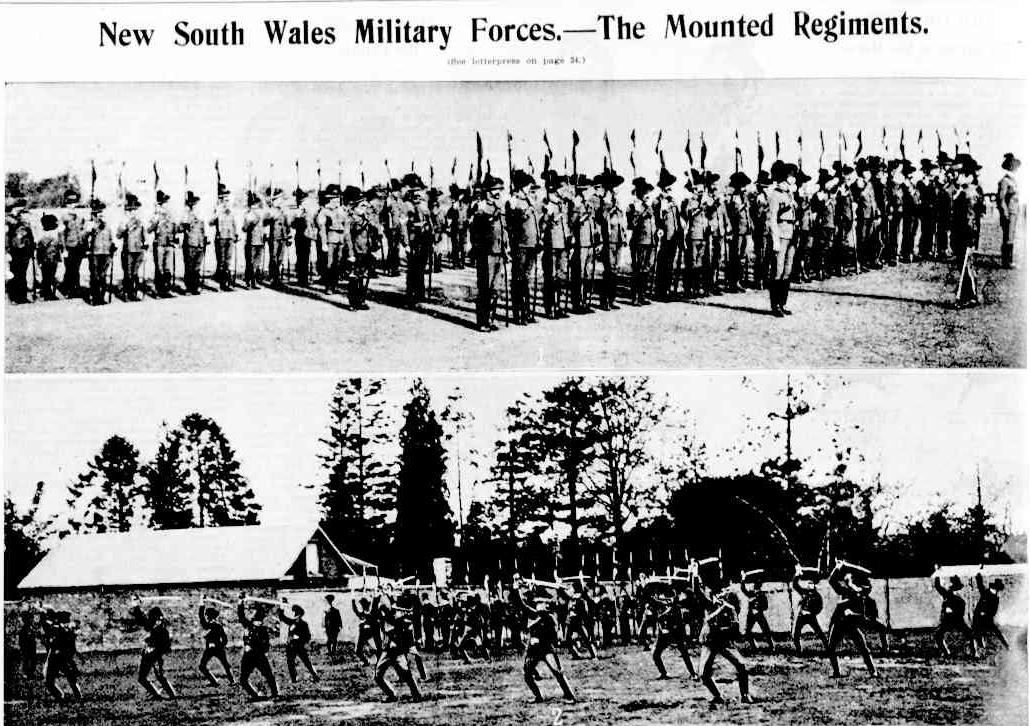
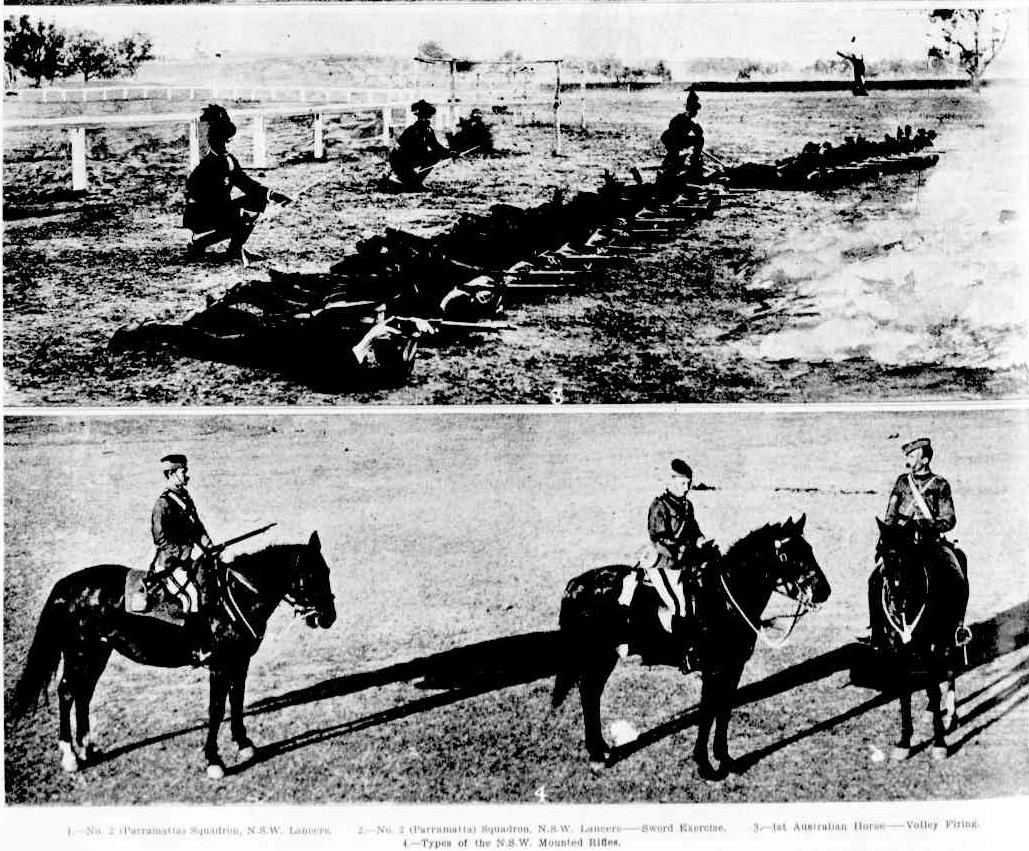
1. No. 2 (Parramatta) Squadron, N.S.W. Lancers. 2. No. 2 (Parramatta) Squadron, N.S.W. Lancers - Sword Exercise. 3. 1st Australian Horse - Volley Firing. 4.-Types of the N.S.W. Mounted Rifles.
New South Wales Military Forces - The Mounted Regiments.
(See Illustrations on page 31.) (Photo. No. 2; by Beavis Brothers, Bathurst.)
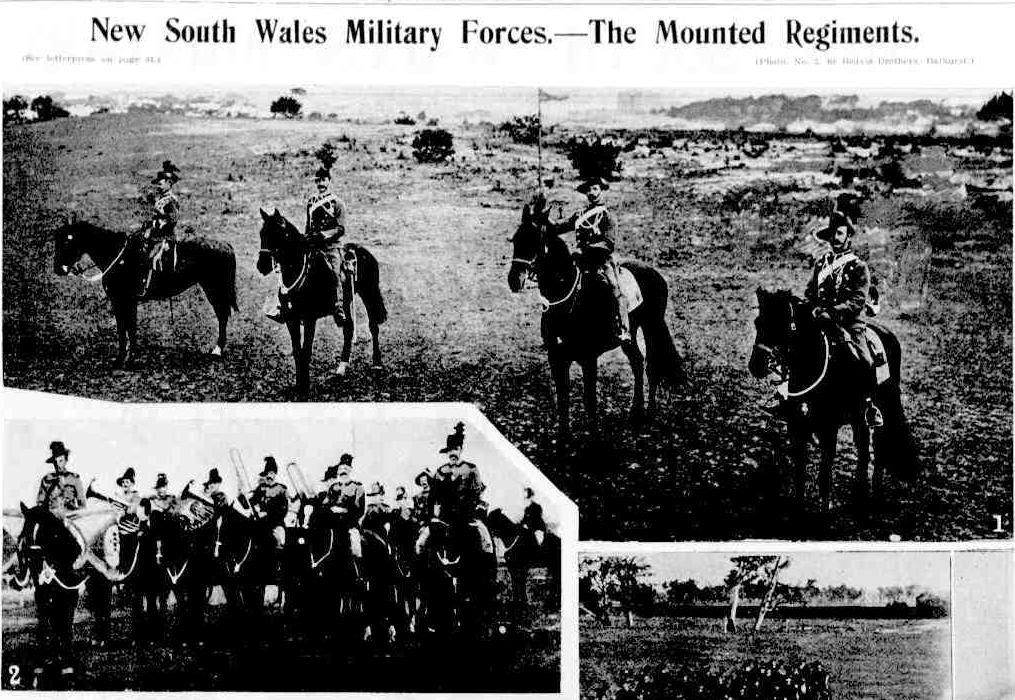
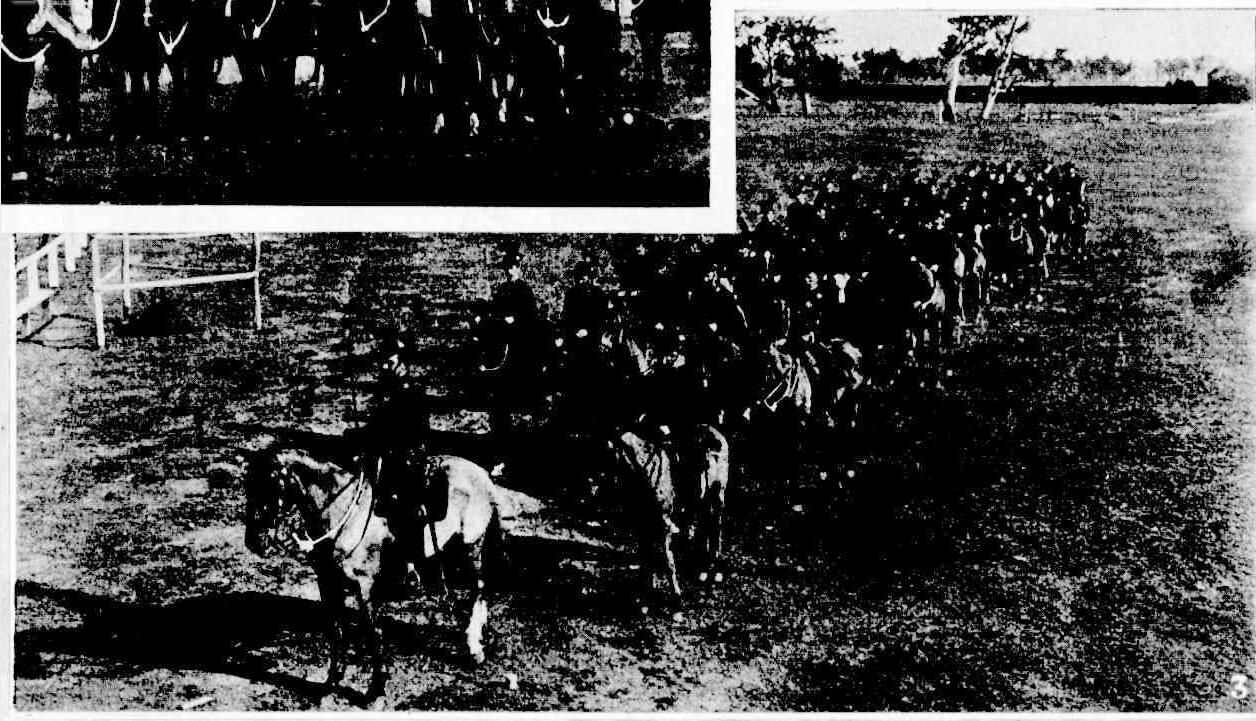
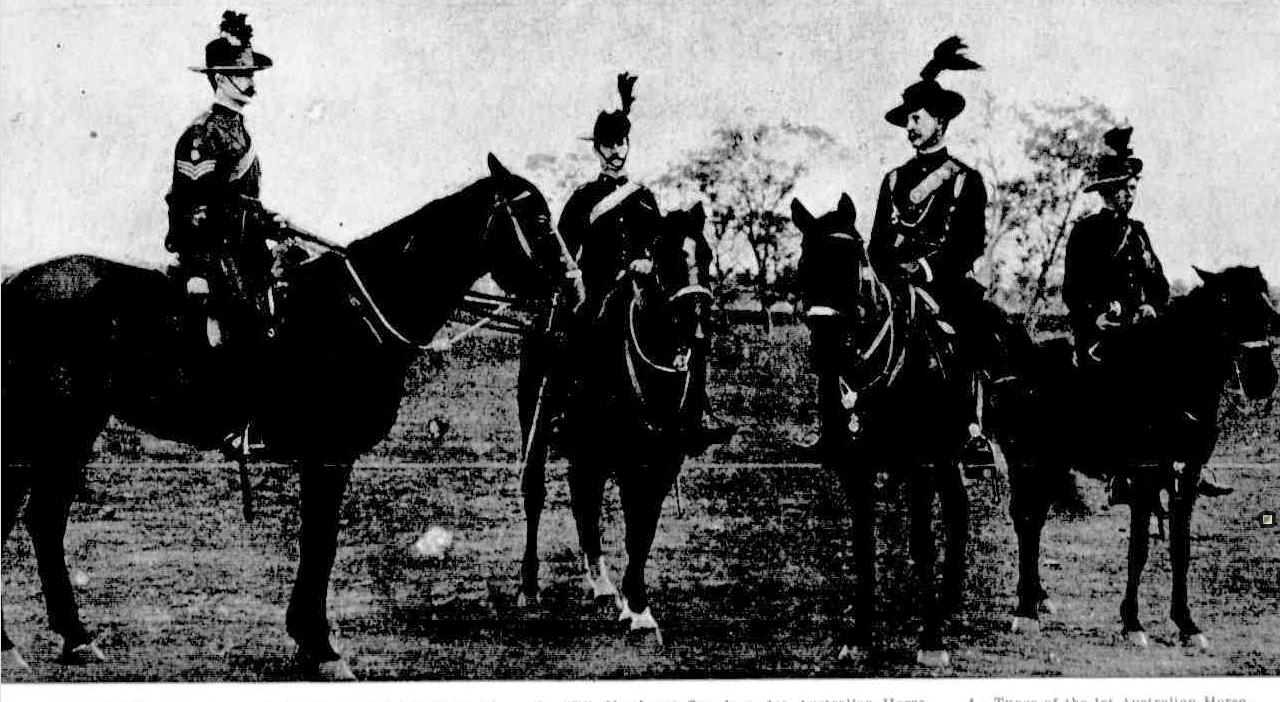
l.-Types of the N.S.W. Lancers. 2,-N.S.W. Mounted Rifles Band. 3,-"D" (Northern) Squadron, 1st Australian Horse 4.-Types of the 1st Australian Horse.
NEW SOUTH WALES MILITARY FORCES-THE MOUNTED REGIMENTS.
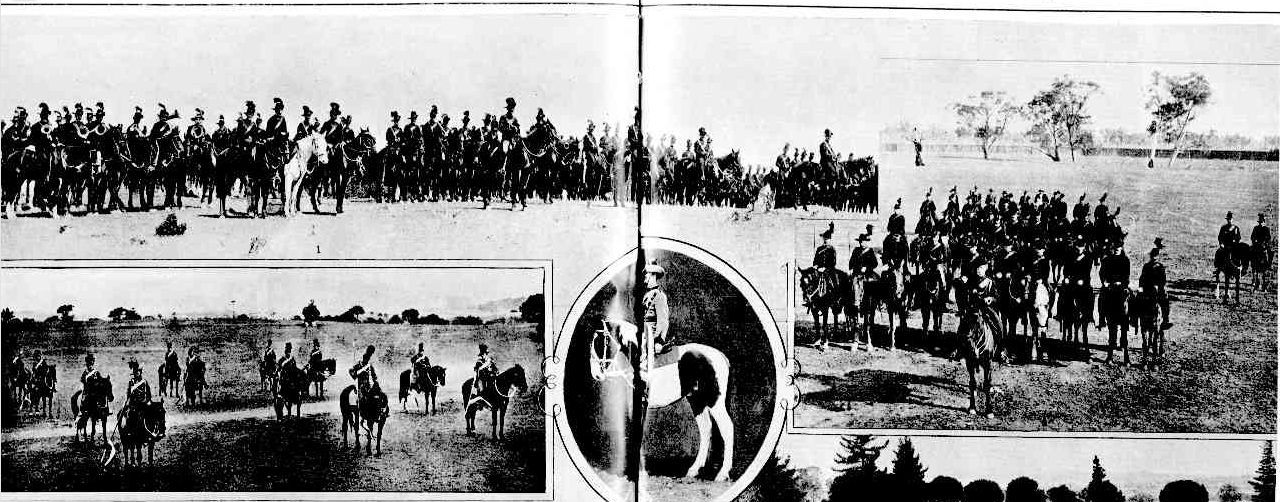

1.-1st Australian Horse. 2.-No. 1 (Sydney) Squadron N.S.W. Lancers'-Lance Exercise. 3.-The Drum Horse, N.S.W. L 6,-Camden Squadron, N.S W. Mo
4. (Northern) Squadron, 1st Australian Horse, In Column of Troops. '-A Half-Squadron In Line. 5,-No. 1 (Sydney) Squadron N.S.W. Lancers. (Photos, No. 1 by Kerry and Co,, Sydney, remainder by G. A. .Hills, 9 Castlereagh-street, Sydney.)
New South Wales Military Forces.
THE MOUNTED REGIMENTS.
(BY 'RANK AMD FILE').
(See illustrations on pages 30, 31, 32, 33, 35, and 36.)
There are many who consider that the experiences of the South African war have, demonstrated the utter uselessness of cavalry in modern warfare, but while it is acknowledged that the campaign afforded few chances for the use of the lance, the opinion of the majority of the more distinguished modern soldiers-Continental as well as British-have not undergone the slightest revision as a consequence. As a matter of fact, some of our generals, while admitting the South Africa lent itself more to the employer of mounted infantry than to cavalry, are more emphatic that the days of the latter have by no means gone by. General Sir John D. French (than whom no other officer was more successful in South Africa), for instance, has stated publicly that he would like to see the mounted infantry branch of the service increased, but added most emphatically that this should not be done at the expense of the cavalry. Speaking of the relative value of the two arms, General French said that personally he would prefer properly horse and equipped cavalry to mounted infantry, but while other distinguished officers are not pre pared to go to that extent, it is generally agreed that future campaigns will provide opportunities for "shock tactics," and consequently for the use of cavalry. That the Imperial Government does not intend to be Influenced by the popular opinion that cavalry will not be required in future campaigns is evident from the statement of Mr. Brodrick (the Secretary of State for War) in the House of Commons that he was not going hastily to adopt the opinion that, because of the experiences of the South African war, cavalry would not be required as before; but that cavalry ought to be taught to shoot well, and to be able to act as mounted infantry no one would deny. This is, as a leading London paper remarked common sense. The elaborate discrimination and distinctions between cavalry and mounted infantry are false and misleading. The true distinction is between horse and foot, as in the days of Cromwell. The horse-soldier must, of course, be much the more accomplished combat ant of the two. He ought to be able to do all that the foot-soldier can do with the rifle, and in addition, be a horseback fighter, as well as a good horse-master. To create a body of imperfect users of the horse for combatant purposes is absurd. Good mounted Infantry should always be capable of doing cavalry work. Good cavalry should always be also good mounted infantry. When a soldier is given any instrument, of war he must make himself as complete a master of it as possible War should know nothing of the water-tight compartments in which "peace generals" ' try to confine combatants.
Notwithstanding that the recent campaign provided so very few chances for the proper employment of the cavalry, it does not follow that the force was idle. The achievements of French Cavalry Division, and the splendid manner in which the force was led and handled, will ever bi remembered as one of the brightest portions o the long and difficult campaign. Elandsgaate provided perhaps the only opportunity for the proper use of cavalry during the war, and then the moral effect produced by the judicious handling of the force contributed largely to the success of the day. But it was in scouting that the Imperial cavalry was found to be weak (due to the method of recruiting for the mounted regiments and to the lack of training received in some duties), while at such work the Australian soldiers-men who have spent a considerable portion of their lives in the bush (and this applies more particularly to the earlier contingents than t( those sent towards the close of the war)-were in a sense simply following their usual occupations.
In Australia the development of mounted Infantry is certain, as the country is more suited to the employment of that branch than to cavalry, At present New South Wales boasts three mounted regiments-the New South Wales Lancers! the Now South Wales Mounted Rifles, and the 1st Regiment Australian Horse.
The New South Wales Lancer Regiment, is the senior regiment in the State, and as such enjoys the privilege of occupying the "right of the line" at reviews. The history of the regiment dates from 1884, when hostilities with Russia appeared imminent. New South Wales, like other portions of the Empire, was looking to her defences, and a suggestion was made that a mounted corps should be formed. The names of a number of young men willing to enrol were collected, a meeting was held in October, and it was decided to apply for the necessary permission for the establishment of a cavalry corps.
The Sydney Light Horse, a force on a purely volunteer basis, was the outcome, and in January, 1885, the men were duly enrolled, Captain Malcolm Macdonald, formerly of the Poona Light Horse, being appointed to the command, with the rank of major. At the same time Mr. (now Captain) R. R. Thompson was appointed warrant officer and instructor to the new corps. Captain Thompson afterwards received a commission, and was appointed adjutant to the 1st Australian Horse on its formation, and ls new adjutant of the "King's Colonials," a regiment raised in London, and composed entirely of men of colonial birth or parentage. The first appearance in public of the Sydney Light Horse was on the occasion of the departure of the Soudan contingent, the corps forming an escort to the Governor, Lord Loftus. Soon afterwards detachments of cavalry were raised in some of the country districts, including West, Camden (under Captain, now Colonel J. A. Kenneth Mackay, C.B., the present officer commanding the 1st Australian Horse), Illawarra, Maitland, Tenterfield, Casino, etc.; and these, with the Sydney troop, constituted the first mounted regiment of the State. The uniform of the Sydney Light Horse in the first Instance was dark blue, the corps being armed with swords and carbines. The Soudan campaign impressed the late Major-General Richardson, C.B. (the then commandant of the New South Wales forces) with the superiority of the lance as a cavalry weapon, and one of his first official acts on returning to Sydney was to convert the Sydney Light Horse into Lancers by adding the lance to the equipment of the corps. New uniforms for the Sydney troop were then ordered from London, the members of the corps; bearing the cost the officers' full dress costing £60 and the men's £10. Lances were also ordered from London, but as these weapons could not become available for some time, it is related that the Sydney troop drilled with barbaric fishing-rods for some months, and actually carried these "weapons" when they formed an escort for Lord Carrington on his arrival in Sydney. It is also stated that one country troop drilled with riding-crops for some time, owing to the fact that arms were not forthcoming; while another turned out to escort the Governor "armed" with stockwhips. It will thus be seen that even in those days, as at present, our volunteers did not receive the encouragement and assistance the Government (which should be grateful for this voluntary service of the men) should give them.
The arrival of Lord Carrington, himself a cavalry officer, acted as a stimulus to the cavalry movement, and-the new Governor, to make his interest in the Lancers more marked, accepted the position of honorary colonel. This position, by the way. Lord Carrington still holds. About 1889 some of the country detachments of the Light Horse were disbanded, and in their places half squadron's of Lancers were raised; while the remainder were converted into Mounted Rifles, under the designation of the Regiment of Mounted Rifles. Captain Malcolm. M'Neill, of the 4tl Hussars, and subsequently A.D.C. to the Duke of Connaught, was then selected as ah instructor to the local forces, and he was most successful in completing the organisation of what is now the , New South Wales Lancer Regiment. In 1893 the Regiment of Mounted Rifles were renamed '"Mounted Rifles," and bridged with the Lancers as the Mounted Brigade, Colonel Macdonald being appointed to the command. With the promotion of Colonel Macdonald, Major A. J Dodds became the commanding officer of the Lancers, the command of the Mounted Rifles being entrusted to Major (now Lieutenant-Colonel; H. B. Lassetter).
In 1894, Major J. J. Walter succeeded Major Dodds in the command of the Lancers, and in June, 1896, Colonel Macdonald retired from the service at his own request, consequent upon advancing years and the general condition of his health. Colonel Macdonald before coming to Australia, served in the Scinde campaign of 1839, and commanded the Poona Horse in Upper Scinde and Beluchistan in 1847 and was incessantly engaged against the Beluohee and Candabaree tribes infesting the frontier, and at the siege of Mooltan In 1848, whilst in India, Colonel Macdonald held numerous important staff appointments, and the announcement of his retirement from the local forces was received with keen regret.
During recent years the New South Wales Lancers have become world-famed, the initiative in that direction being taken in 1893, from which date the regiment's association with the mother country began. In the year mentioned a detachment of the regiment, under Major Dodds with Warrant-Officer (now Captain) Thompson as instructor, visited England for the purpose of competing at the Islington and Dublin military tournaments. The team succeeded in winning twenty-six' prizes; Sergeant Daly, of Lismore winning the Empire gold medal. This detachment, it should be stated, went to England at the sole expense of the regiment, the Government of the day doing all in its power to thwart rather than facilitate the object. Another detachment of the Lancers visited England in 1897, the occasion being the Record Reign, celebrations. This detachment consisted of 33 officers, non-commissioned officers, and men; Captain (now Lieutenant-Colonel) W. L. Arernon being in command. The other officers were Lieutenant (now Lieutenant-Colonel) C. F. Cox, Lieutenant (now Captain) F. H. King, and Lieutenant (now Captain) F. C. Timothy. The expense of this detachment was defrayed by regimental and private subscriptions, the success of the movement being due to a large extent to the present commanding officer, Lieutenant-Colonel (then Major) J. Burns. The picturesque uniform of the regiment brought forth much favourable comment in England, and a number of the men distinguished themselves at the Islington tournament. Major (now Lieutenant-Colonel) Burns succeeded to the command of the regiment in
1897, and one of his early .important acts was the offer of a squadron of the regiment for service in the Africa campaign, but the Government declined to submit the proposal to the Imperial authorities. Colonel Burns was, however, determined to Increase the efficiency, of his command, and a movement to dispatch a squadron to England for a thorough training with the Imperial troops was warmly taken up.
Approval of this object was ultimately obtained, the regiment agreeing to pay half the cost, and the Government the other half. Colonel Burns at this time visited England, and personally arranged for the course of training. Lord Carrington did every thing possible to forward the object, but Colonel Burns, on his return to Sydney, was greatly disappointed to find that the Government had failed to keep its promise to contribute half the cost of sending the squadron to England. The Labour party was opposed to the proposal, and to avoid the possibility of political complications, the Government decided not to put the amount on the Estimates. But Colonel Burns and his supporters persevered; the men selected agreed to contribute £20 each (thus accounting for £2000), another £1000 was subscribed In England, and an additional £1000 was raised by the officers and friends of the regiment. The necessary funds having been obtained, the squadron, consisting of 106 officers, non-commissioned officers, and men, embarked in March, and the squadron was the first colonial troops to visit England for the express purpose of receiving training with the Imperial forces. The squadron (which was commanded by Captain CF. Cox, the other officers being Lieutenants S. F. Osborne and W. J. S. Rundle) was likewise the first colonial troops to serve in the South African campaign. It is well known how, on the squadron reaching Capetown, en route from London to Sydney, the services of the men were accepted by the Imperial Government, and it is equally well known how the squadron distinguished itself at the various battles fought during the early stages of the war. Other colonial forces soon afterwards began to arrive at the seat of war; more Lancers were sent;-and altogether the part played by officers and men during the war added additional lustre to the regiment and honour to the local forces as a whole.
The regiment was originally composed of four squadrons of 100 each, by the strength and distribution of the regiment present is at follows: No. 1 (Sydney) Squadron No. 2 (Parramatta) Squadron; No. 3 (West Garden-Berry) Squadron, composed of half-squadron at West Camden and Berry; No. 4 (Martian Singleton) Squadron, composed of half-squadron at Maitland and Singleton; No. 5 (Casino-Lismore) Squadron, composed of half-squadrons ; Casino and Lismore; No. 6 (Richmond1-Windijo Squadron, composed of half-squadrons at Richmond and Windsor; and1 the Newcastle Half Squadron. There is mil soi a cadet half-squadron at Parramatta. Among the illustrations is pictures of the Sydney Squadron (which is commanded by Captain F. H. King) in review work While other pictures show the Parramatta Squadron (Commanded by Captain R. C. Mackenzie) column of half-squadrons, and at sword exercise and a portion of the Sydney Squadron at lance exercise. The pictures of the Parramatta Squadron show the drill order uniform of the regiment. In the picture of "types of the regiment" are shown an officer (Captain F. H. King a non-commissioned' officer, a trooper, and trumpeter. A picture of the splendid regimental band is also given, as well as an illustration of the drawn horse.
Although the youngest of the mounted regiments, the 1st Australian Horse follow the Lancers in seniority. The history of the Australian Horse dates from June, 1897, when permission was given to raise a regiment of bushmen on a purely volunteer basis. Lieutenant-Colonel J. A. Kenneth Mackay was appointed to the command of the new regiment. Captain Ferguson, of the 2nd Life Guan and private secretary to the Governor, accepted the position of second in command with the ran of major (but was soon afterwards seconded c returning to England), and Lieutenant R. 1 Thompson was appointed adjutant. The decision to raise the regiment was received with the utmost enthusiasm all over the country, and in very little time the regiment was recruited up to the authorised strength. The well-known myrtle green uniforms of the regiment were imported from London, and these were Issued to the men in camp at Rookwood in April 1898. The arrival in camp of small bodies of civilian horsemen -real bushmen in appearance--will ever be remembered by those who witnessed the sight, as when, a few hours later, the regiment marched past in review order, the impression created of both, the military and public mind was the most favourable, and from that time the popularity of the "green hats" began.
The regiment originally consisted of four squadrons, but about 1901 when it was placed on the partially-paid establishment, another squadron was added. The strength of the regiment is now about 600 of a ranks. "A" (Southern) Squadron has detachments at Murrumburrah-Harden, Cootamundra and Gundagai-Adelong; "B" (South-Eastern) Squadron consists of troops at Goulburn, Bungendore, Braidwood-Araluen, and Michelago-Bredbo. The regimental band, of which an illustration is given, is also stationed at Goulburn. "C" Squadron is recruited in the western district, there being troops at Mudgee, the Cudgegong, and Rylstone; while "D" (Northern) Squadron has half-squadrons at Scone and Muswellbrook, and a detachment at Belltrees. "E' Squadron is also a northern squadron having detachments at Gunnedah, Boggabri, and Tamworth. The pictures include several illustrations of "D" Squadron, commanded by Captain R. H. E. Upton. The squadron is shown in a column of troops and also in fours, Captain Upton being the officer leading the squadron in the latter picture. The officer in front of the squadron in the former picture is Lieutenant E. R. White, of the Muswellbrook Half-Squadron. Other pictures show the regiment formed up, a half-squadron in line (mounted and dismounted), and a half-squadron firing volleys. In the illustration of "types of the regiment" appear an officer, a non-commissioned officer, a trooper, and a trumpeter. The Goulburn troop is also illustrated. Colonel Mackay, who still commands the regiment, served in South Africa first in command of the Imperial Bushmen, and afterwards as Staff Officer for Oversea Contingents at Capetown, and for his services was created a Companion of the Bath. Captain K. M. Wray, D.S.O., is at present acting as adjutant of the regiment, and he also served during the South African campaign. Several detachments of the regiment took part in the war, performing excellent work with General French's cavalry division, and earning the gratitude of that distinguished officer. A number of officers and men of the regiment also served with other New South Wales contingents. Earl Beauchamp, formerly Governor of New South Wales, is the honorary colonel of the 1st, Australian Horse.
The circumstances which led to the formation of the original detachments of the New South Wales Mounted Rifles have already been explained, Lieutenant-Colonel Lassetter being the first commanding officer of the regiment. Colonel Lassetter was then an Imperial officer, lent to the New South Wales Government, and to his energy is due in a great measure the present high state of efficiency of the regiment. The original companies of the Mounted Rifles were at Picton, Queanbeyan, Bega, Tenterfield, Inverell, and Campbelltown, Camden and Liverpool being added in 1891.
Three years later in 1894-the regiment was reorganised by Major-General Hutton, and is now distributed as follows:-No. 1 (Molong-Bathurst) Squadron, with half-squadrons at Molong and Bathurst; No.2 -(Picton-Camden) Squadron, with half-squadrons at Picton and Camden; No. 3 (Bega-Forbes) Squadron, with half-squadrons at Bega and Forbes; and No. 4 (Tenterfield-Inverell) Squadron, with half-squadrons at Tenterfield and Inverell. A volunteer half-squadron, formed from the Enfield and Canterbury districts, is attached to the regiment.
The authorised establishment of the regiment is 460 of all ranks. In 1897, under Lieutenant-Colonel Lassetter's energetic management, funds were raised regimentally for a detachment of the regiment to go to England for the Record Reign, celebrations. The detachment also took part in the military tournaments at Dublin and Islington, and was very successful. The detachment remained In England from May to September 1897, and during that time was attached for training to the Znu Dragoons (Royal Scots' Grey»), and to the 6th Dragoon Guards , (Carabineers), and was the first body of New South Wales troops that received training with Imperial troops.
New South Wales Military Forces. The Mounted Regiments.
(See letterpress on page 34.) (Photos. Nos. 2, 3, and 4 by Rozelle Studio, Goulburn.)
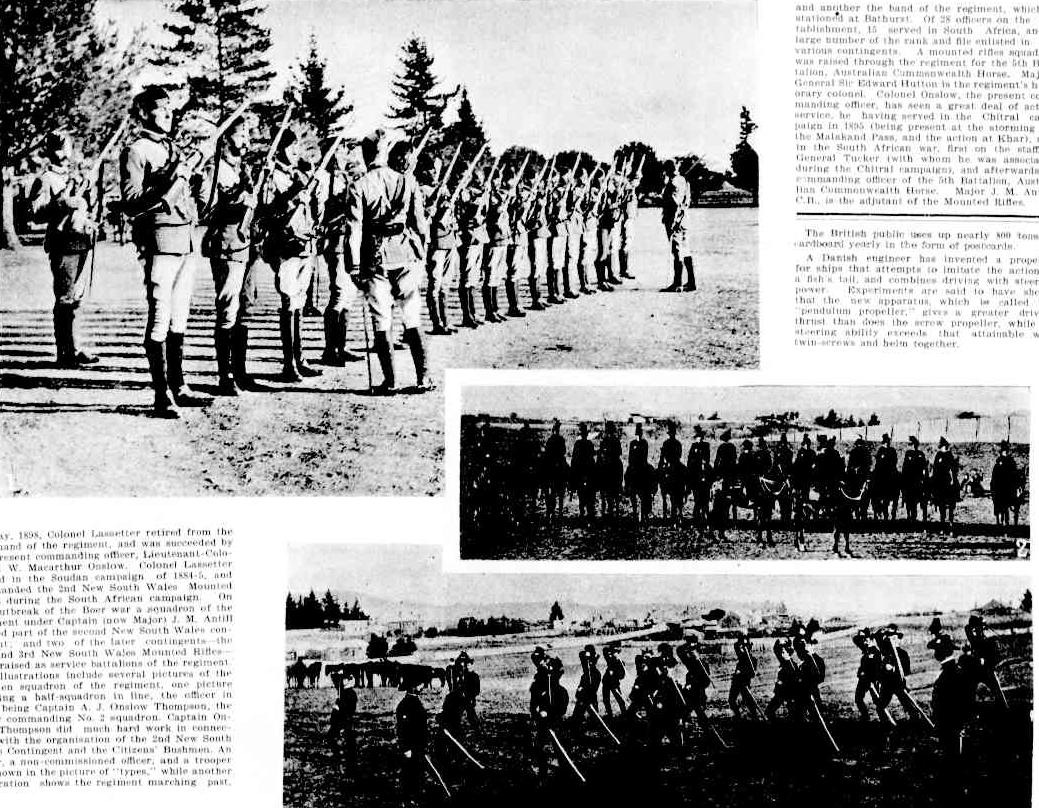
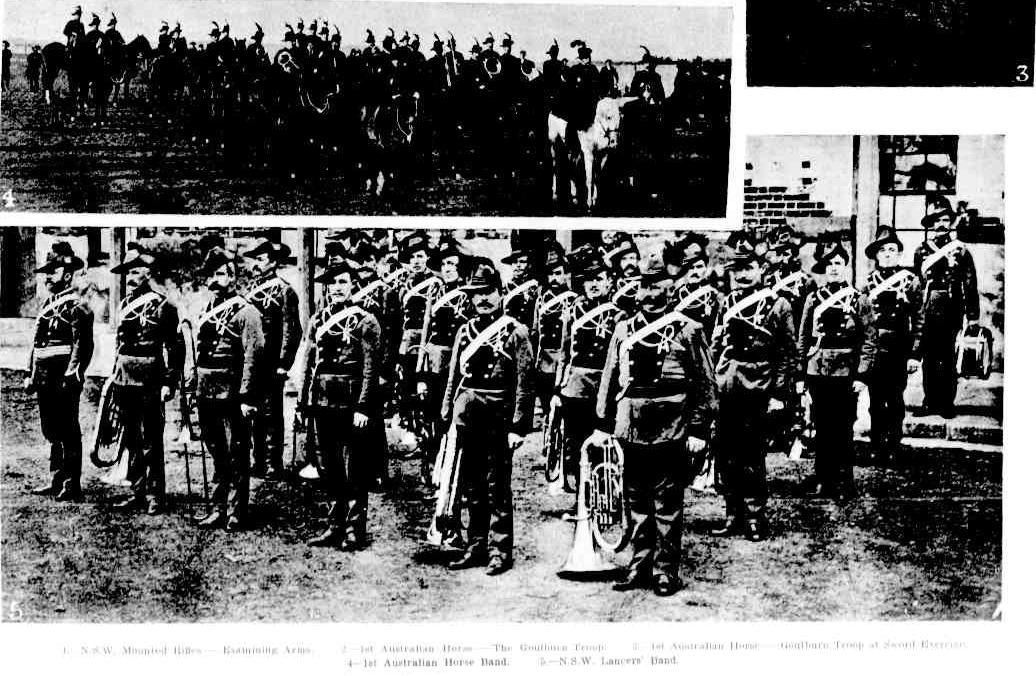
1.-N.S.W. Mounted Rifle-Examining Arms. 2.-1st Australian Horse-The Goulburn Troop. 3.-1st Australian Horse-Goulburn Troop at Sword exercise.
4-1st Australian Horse Band, 5.-N.S.W. Lancers' Band.
In May, 1898, Colonel Lassetter retired from the command of the regiment, and was succeeded by the present commanding officer, Lieutenant-Colonel J. W. Macarthur Onslow. Colonel Lassetter served in the Soudan campaign of 1884-5, and commanded the 2nd New South Wales Mounted Rifles during the South African campaign. On the outbreak of the Boer war a-squadron of the regiment under Captain (now Major) J. M. Antill formed part of the second New South Wales contingent; and two of the later contingents-the 2nd and 3rd New South Wales Mounted Rifles were raised as service battalions of the regiment. The illustrations include several pictures of the Camden squadron of the regiment, one picture showing a half-squadron in line, the officer in front being Captain A. J. Onslow Thompson, the officer commanding No. 2 squadron. Captain Onslow-Thompson did much hard work in connection with the organisation of the 2nd New South Wales Contingent and the Citizens' Bushmen. An officer, a non-commissioned officer, and a trooper are shown in the picture of "types," while another illustration shows the regiment marching past, and another the band of the regiment which is stationed at Bathurst. Of 28 officers on the establishment, 15 served in South Africa, and a large number of the rank and file enlisted in the various contingents. A mounted rifles squadron was raised through the regiment for the 5th Battalion, Australian Commonwealth Horse. Major General Sir Edward Hutton is the regiment's honorary colonel. Colonel Onslow, the present commanding officer, has seen a great deal of active service, he having served in the Chitral campaign in 1895 (being present at the storming of the Malakand Pass, and the action at Khar), and In the South African war, first on the staff of General Tucker (with whom he was associated during the Chitral campaign), and afterwards as commanding officer of the 5th Battalion, Australian Commonwealth Horse. Major J, M. Antill, C.B., is the adjutant of the Mounted Rifles.
New South Wales Military Forces.—The Mounted Regiments.
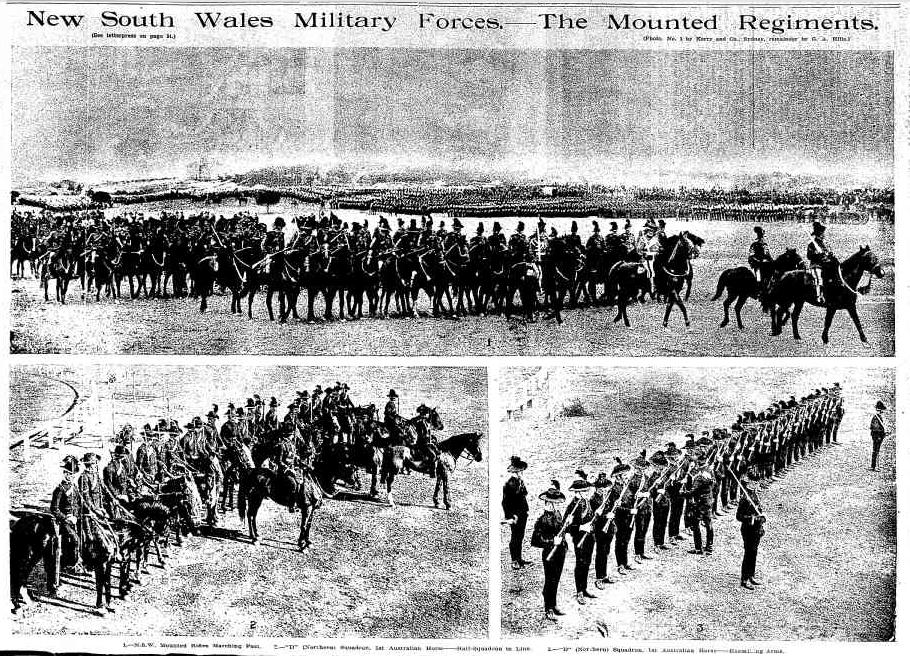
(See letterpress on page 34.) (Photo. No. 1 by Kerry and Co., Sydney, remainder by G. A. Hills.)
1.—Mounted Rifles Marching Past. 2.—"D" (Northern) Squadron, 1st Australian Horse—Half-Squadron in Line. 3.—"D" (Northern) Squadron, 1st Australian Horse—Examining Arms.
New South Wales Military Forces. (1902, October 22). Australian Town and Country Journal (Sydney, NSW : 1870 - 1907), p. 30. Retrieved from http://nla.gov.au/nla.news-article71494313
For more information on Camden connections visit previous pages Sundial of Human Involvement at The Australian Botanic Garden Mt Annan – Royal Botanic Gardens & Domain Trust Australian Botanic Garden and St Johns Camden: 176th And 167th Anniversaries In June 2016 - the church successive generations of M'Arthurs have been married in.
In September 1914, the 6th Light Horse Regiment Australian Imperial Force was raised at Holsworthy Military Camp under the command of Lt Col C. F Cox CB, CMG, DSO, VD also a Boer War veteran who had distinguished himself while in command of a squadron of New South Wales Lancers during the conflict in the South Africa. On the 19th of December 1914, the Regiment sailed aboard the transport "SUEVIC", bound for Egypt and the Suez Canal.
LIGHT HORSEMEN OF THE SECOND AUSTRALIAN IMPERIAL FORCE.
The 6th Light Horse Regiment, under the command of Lieut. Colonel Cox, C.B., V.D., and the 7th Regiment, under the command of Lieut.Colonel Arnott, are now encamped at Holdsworthy, about four miles from Liverpool. These regiments belong to Colonel Ryrie's Light Horse Brigade, and are composed of men of the very best type, all of them being well set up young fellows in perfect condition, who can both ride and shoot well. Colonel Cox is popularly known as 'Fighting Charlie,' because in the South African War he was always eager for the fray, and led his men confidently and well.
LIEUTENANT-COLONEL C. F. COX AND OFFICERS OF THE 6TH A.L.H. REGIMENT. Light Horse. (Reading Left to Right)— Lieut. ….
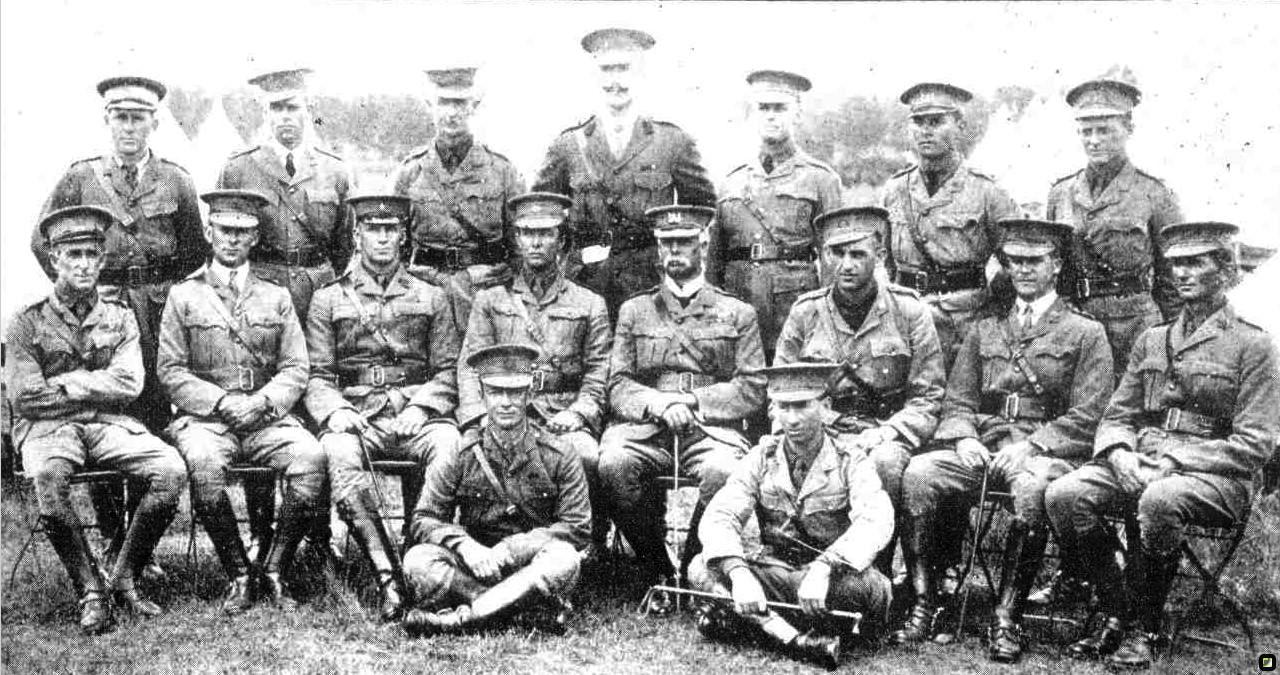

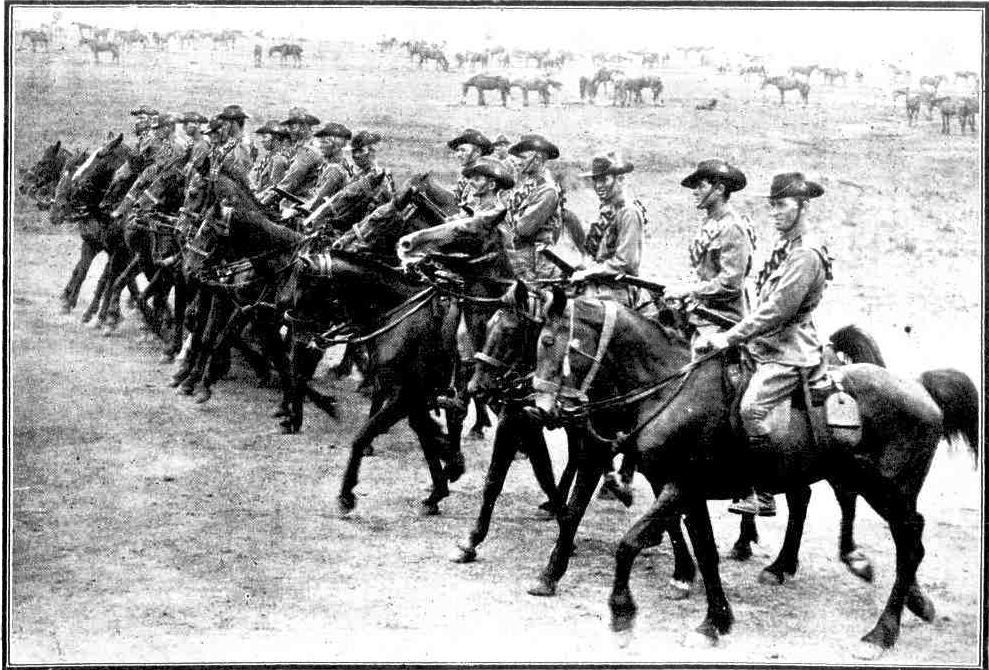
A TROOP OF THE 6TH (N.S.W.) AUSTRALIAN LIGHT HORSE.
LIGHT HORSEMEN OF THE SECOND AUSTRALIAN IMPERIAL FORCE. (1914, November 25). Sydney Mail (NSW : 1912 - 1938), p. 13. Retrieved from http://nla.gov.au/nla.news-article166252416
A TROOP OF THE 6TH (N.S.W.) AUSTRALIAN LIGHT HORSE REGIMENT.
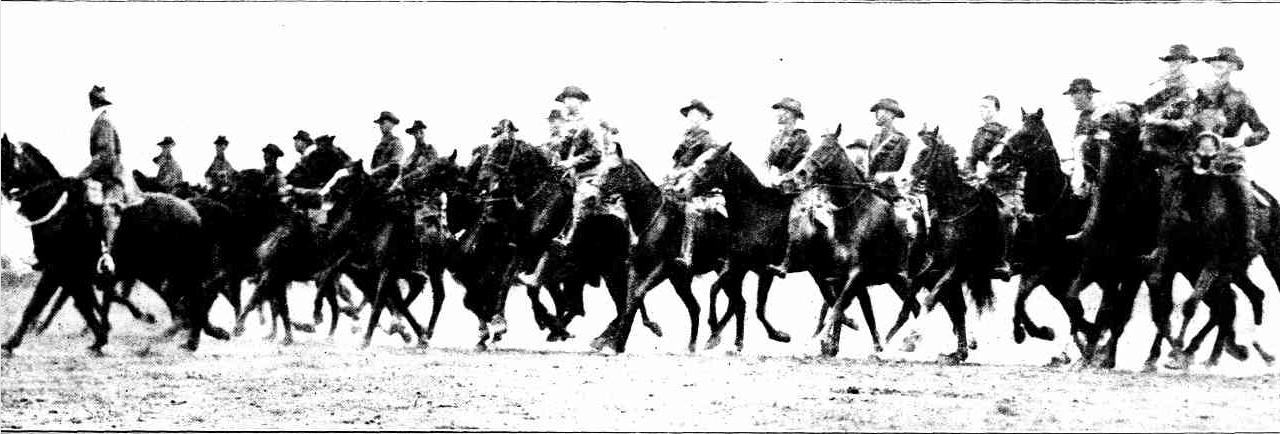
Most of the men forming this splendid regiment are from the country districts of New South Wales, and all are fine riders and good shots, while many of them served in South Africa.
MEN OF THE 5TH (QUEENSLAND) AUSTRALIAN LIGHT HORSE REGIMENT.

This regiment, which, like the 6th (Lieut. -Colonel Cox) and 7th (Lieut.-Colonel Arnott), belongs to Colonel Ryrie's brigade of the Second Australian Imperial Force, is now encamped near Liverpool. It is commanded by Lieut. -Colonel Harris, V.D.
A TROOP OF THE 6TH (N.S.W.) AUSTRALIAN LIGHT HORSE REGIMENT. (1914, December 2). Sydney Mail (NSW : 1912 - 1938), p. 10. Retrieved from http://nla.gov.au/nla.news-article166252740
FROM HOLDSWORTHY TO SYDNEY: THE MID-DAY HALT.
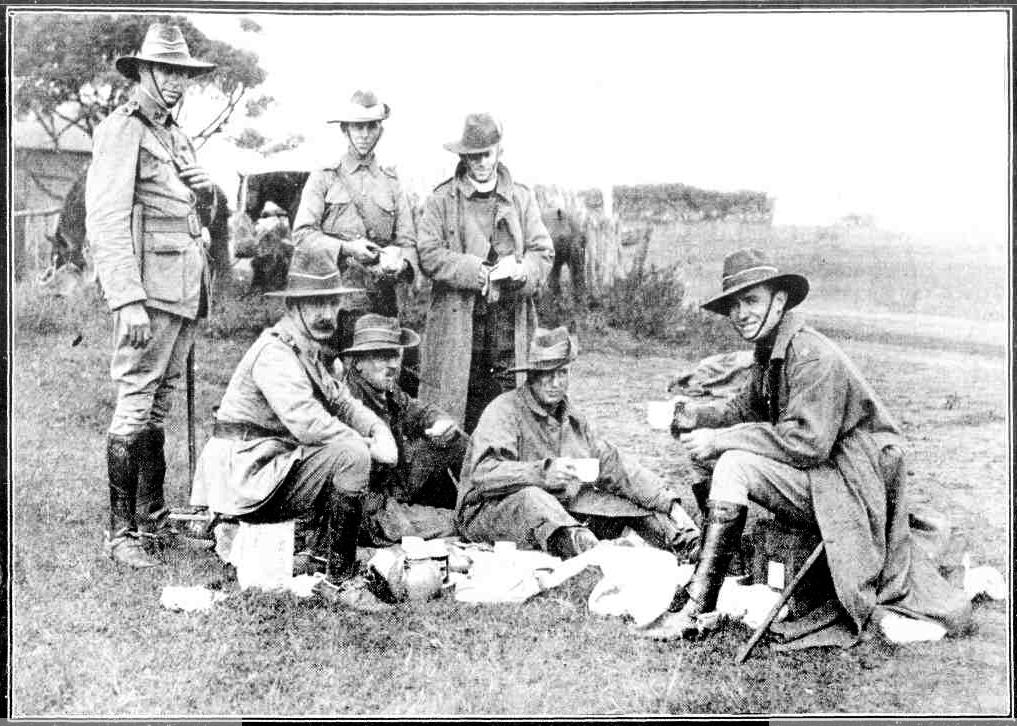
OFFICERS OF THE 12TH LIGHT HORSE.
THE 12th Australian Light Horse Regiment, which is commanded by Lieutenant-Colonel Abbott, of Armidale (the representative of New England electorate in the Commonwealth Parliament), marched on Friday from Holdsworthy camp to Sydney to take part in Saturday's great procession through the city streets. The accompanying pictures were taken during a halt on the way.
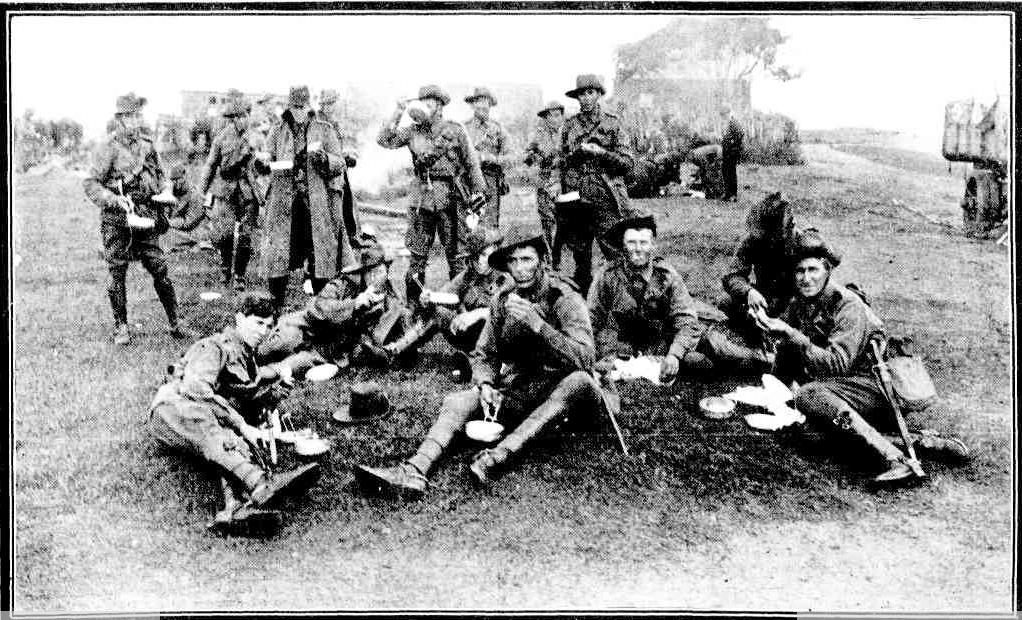
AMONG THE RANK AND FILE OF THE 12TH A.L.H.
FROM HOLDSWORTHY TO SYDNEY: THE MID-DAY HALT. (1915, April 28). Sydney Mail (NSW : 1912 - 1938), p. 19. Retrieved from http://nla.gov.au/nla.news-article166255171
4th LIGHT HORSE ENCAMPMENT AT CASINO, N.S.W.
The troops comprised 14 officers and 300 men under the command of Major Board. The encampment extended over a week, and proved successful.
AUSTRALIAN LIGHT HORSEMEN WHO WILL SHORTLY BE LEAVING FOR THE FRONT. The men appear to be well protected against cold and rain. Indeed, the equipment of our troops is in every way excellent. Letters from Australians in Egypt state that their clothing and equipment generally have aroused the admiration and envy of the British Territorials. 4th LIGHT HORSE ENCAMPMENT AT CASINO, N.S.W. (1915, May 5). Sydney Mail (NSW : 1912 - 1938), p. 28. Retrieved from http://nla.gov.au/nla.news-article166254524
TRAINING FOR ACTIVE SERVICE: MEN OF THE 12th A.LH.
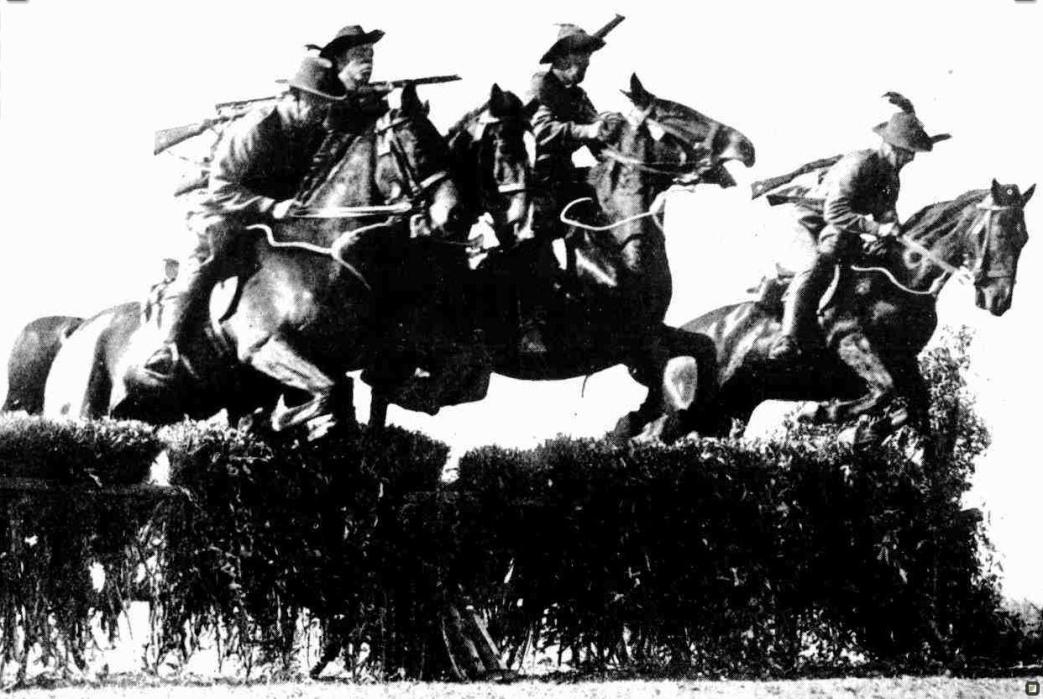
A PATROL CLEARING AN OBSTACLE.
THE mounted troops sent away by Australia have won high praise from all who have seen them at work in Egypt. It is evident from the casualty lists that many of them are now at the Dardanelles, where they are being used as infantry. The fact that they have not been able to take their horses with them must have caused thorn considerable disappointment, but they have doubtless found compensation in the knowledge that they are at last in the firing line. The training they have received will enable them to do their part worthily beside their infantry comrades, both in the trenches and in the charges for which the Australians have become famous. The 12th Light Horse Regiment, which is commanded by Lieut.-Colonel Abbott, has be;' brought to a very high state of efficiency at Holdsworthy, and should give an excellent account of itself when it reaches the front.
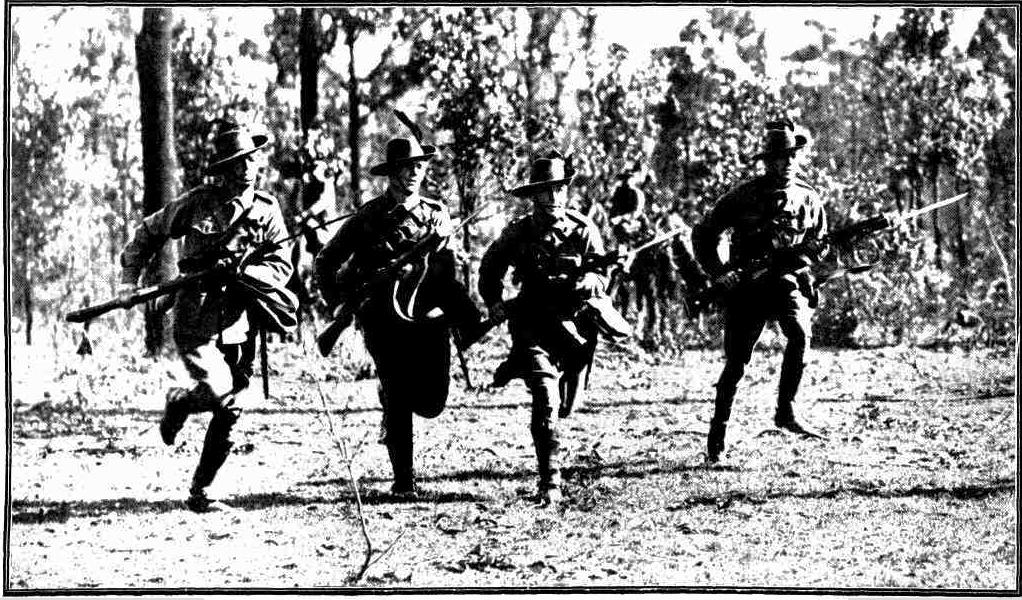
LIGHT HORSEMEN PRACTISING A BAYONET CHARGE.
TRAINING FOR ACTIVE SERVICE: MEN OF THE 12th A.L.H. (1915, June 9).Sydney Mail (NSW : 1912 - 1938), p. 10. Retrieved from http://nla.gov.au/nla.news-article166255704
TRANSPORTING AUSTRALIAN LIGHTHORSE
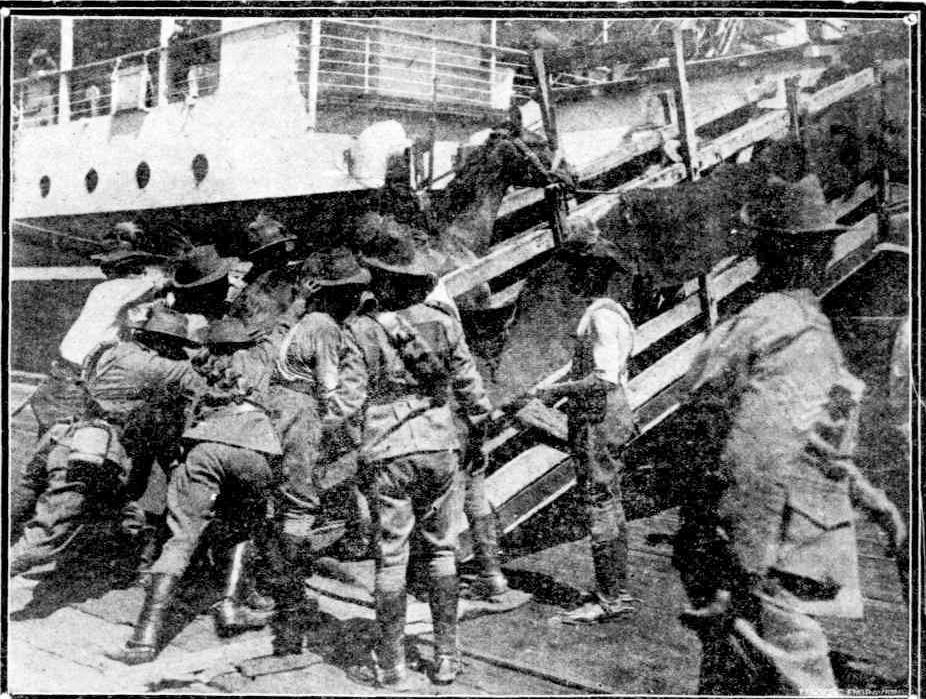
SCENE AT THE EMBARKATION OF THELIGHT HORSE, GIVING AN IDEA OF THE DIFFICULTIES OF THE WORK. TRANSPORTING AUSTRALIAN LIGHT HORSE (1915, June 13). Sunday Times (Perth, WA : 1902 - 1954), p. 6. Retrieved from http://nla.gov.au/nla.news-article57800493
MACHINE GUNNERS OF THE 12th AUSTRALIAN LIGHT HORSE.
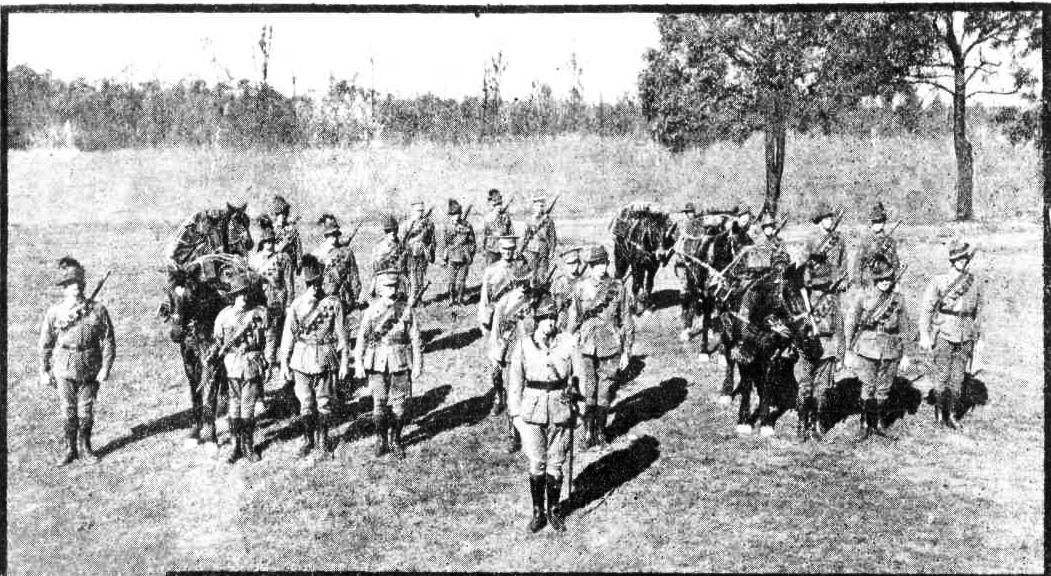
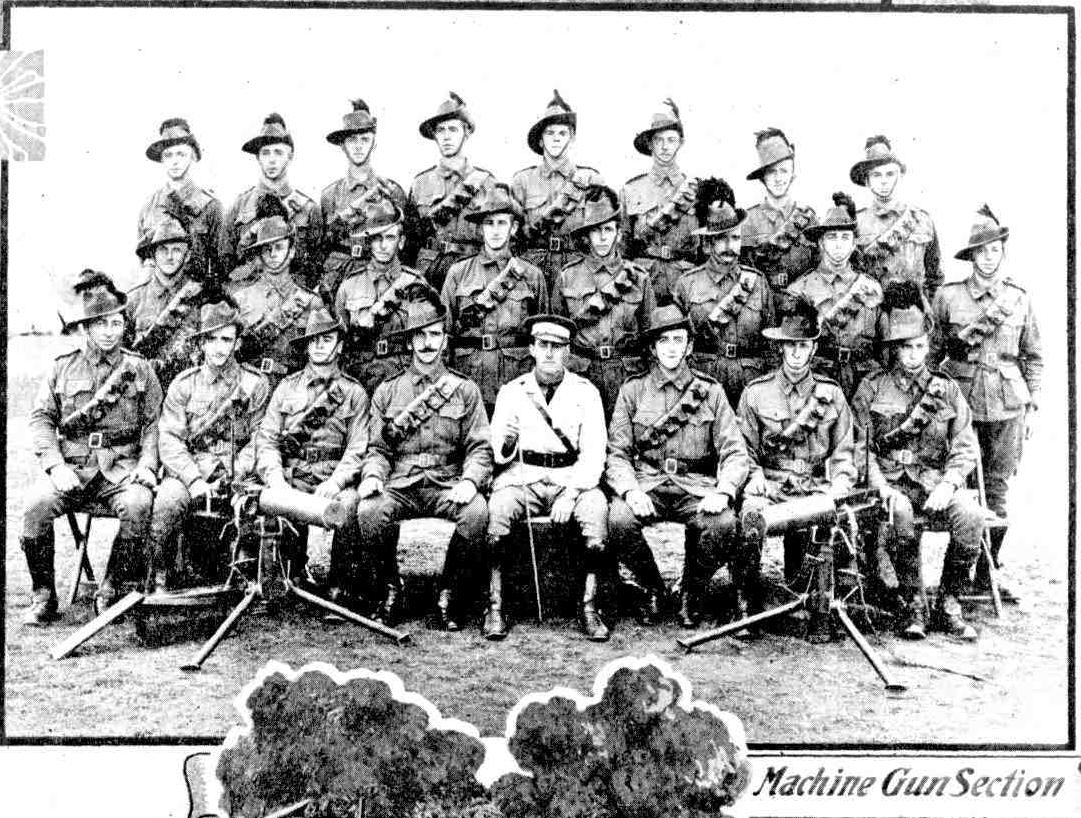
IN the last issue of the 'Mail' there appeared a number of photographs in connection with the 12th A.L.H., commanded by Lieut. -Colonel Abbott. These showed various aspects or camp life and of the work of the Signallers' section. This week we show the Machine-gun section of the regiment. The Allies have hitherto been at a great disadvantage, compared with the Germans, in the matter of machine-guns. We are told that the Kaiser's troops have one of these deadly little weapons for every ten men! The Allies have so realised their value that they are now having them manufactured in vast numbers. Before long the British Army, as well as the Navy, will probably be supplied with the Caldwell machine-gun, an Australian invention, which is said to have many advantages over any other kind. MACHINE GUNNERS OF THE 12th AUSTRALIAN LIGHT HORSE. (1915, July 14). Sydney Mail (NSW : 1912 - 1938), p. 13. Retrieved from http://nla.gov.au/nla.news-article162494184
THE 4TH LIGHT HORSE.
As the 4th Light Horse Brigade has been split up and allotted to other units of the Australian Imperial Force, it is thought (announce the 4th Military District authorities) that the following sample addresses will be of value. The original regimental numbers in addition to rank will still be used:—(a) No. 1234 Private Thomas Atkins, 9th Light Horse Regiment (formerly "C" Squadron, 11th Light Horse Regiment), 3rd Light Horse Brigade, Australian Imperial Force, Egypt; (b) No. 1234 Private Thomas Atkins. 2nd Australian Divisional Train (formerly 4th Light Horse Brigade Train), 2nd Australian Division, Egypt. THE 4TH LIGHT HORSE. (1915, November 13). Barrier Miner (Broken Hill, NSW : 1888 - 1954), p. 4. Retrieved from http://nla.gov.au/nla.news-article45377028
The 4th Light Horse Regiment was a mounted infantry regiment of the Australian Army during the First World War. The regiment was raised in August 1914, as the divisional cavalry regiment for the 1st Division. The regiment fought against the forces of the German Empire and the Ottoman Empire, in Egypt, at Gallipoli, on the Western front, on the Sinai Peninsula, and in Palestine and Jordan. After the armistice the regiment eventually returned to Australia in March 1919. For its role in the war the regiment was awarded twenty-one battle honours.
After training, they landed at Gallipoli on the 20th of May 1915. The regiments distinguished service on Gallipoli and in the Middle East is well recorded. Shrapnel Gully, Johnsons, Jolly, Romani, Amnan, Es Salt, Beersheba, Gaza, Meggido, the Jordan Valley. At Romani it was the first time that they had served together as a complete mounted Regiment and, along with other Light Horse units, took over 11,000 prisoners.
Letter From Trooper Sherwin.
In a letter to his mother (Mrs. C. Sherwin, of Cargo) written at Ma'adi Camp, on May 9, Trooper Norman Sherwin says :-.
We are leaving for the Dardanelles this coming week, without our horses-we are going as infantry. The machine guns are leaving to-night, C. Sherwin among them. It is only the infantry that has fought at the Dardanelles, so far. Tom Byrnes was among them. I went to Caro yesterday to try and find out if anything had happened to him ; but I could get no news whatever concerning him. I saw hundreds of the wounded. They are all anxious to get back again. I hope we will be able to make up for some of the damage the Turks have done to our chaps. They tell me that the Turks cut the tongues out of two of our buglers.
At this camp they took up a collection, and with the money bought 1400 packets of cigarettes for the wounded, which were appreciated very much. There is about £2 10s over.
The natives here can make use of almost anything. They gather up manure, wet it, patter it out like a pancake, dry it in the sun, and use it as fuel. That is the only fuel they use. I was on police duty one night here, in Ma'adi, at the "Nile Cafe." Had to settle a few disputes as to prices, etc. It is not the best job in the world. After closing up, the proprietor treated us to a good dinner and drinks.
Shifting from here is now only a matter of days. I will be glad when we get into action. We are just bursting for something to do. I expect we will be at the Turks long before you receive this letter. Do not be anxious about me, as I can look after myself alright. At any rate, I hope to come through without being too much knocked about. ... It may be a long time before you hear from me again. Letter From Trooper Sherwin. (1915, June 26). Molong Express and Western District Advertiser (NSW : 1887 - 1954), p. 14. Retrieved from http://nla.gov.au/nla.news-article101049044
On the 28th of June 1919, a total of 15 officers and 391 other ranks sailed for home after having been detained since the previous December due to their policing duties during the Egyptian Rebellion, finally arriving in Sydney on the 3rd of August 1919. The command at this time fell to Major D.G. Cross, Lt Colonel C.D. Fuller DSO - Order of the Nile, having taken temporary command of the 2nd Light Horse Brigade. During the Regiments almost five years on active service, it received 5 DSOs, 5 MCs, 6 DCMs, 13 MMs and was awarded 5 foreign decorations. The Regiment suffered 134 deaths either killed in action or died of wounds, etc. had 461 wounded in action, 1265 were evacuated through illness and had 16 taken prisoner of war. [1. 2.]
The RSL Virtual War Memorial lists all members of the 6th ALH - but not their horses, here: https://rslvirtualwarmemorial.org.au/explore/units/214/people?page=6
References
1. Australian Light Horse Organisation - Retrieved from webpage page http://www.lighthorse.org.au/resources/units-in-service/6th-light-horse-regiment
2. TROVE - Australian National Library